Update changes are tagged with their corresponding version numbers throughout the wiki.
- [V11] Pack content that was added or updated in the current version.
- [V1] to [V10] Pack content that was added or updated in former versions.
- [V1 removed] to [V10 removed] Pack content that was removed from former versions.
¶ V11 Gameplay Tag Update
Good news! The long-awaited Gameplay Tag Update is finally here! 🚀
It took quite a while to get it done, as it brings fundamental changes to many Blueprints and Widget Blueprints by adding and updating several features, providing quality of life and fixes, as well as doing lots of chores along the way.
Many thanks to our customers for all the ideas and input for this update.
IMPORTANT NOTE:
If you want to upgrade an existing project to Character Editor V11, please review the showcase video and change log, carefully, and see Getting Started ➝ Character Editor V11 - Upgrade from V10. If you start new Unreal Engine 5.4+ project, see Getting Started ➝ Character Editor V11 - From Scratch.
With that being said, let's kick off the news!
¶ Update Showcase Video
[YouTube PdMTVS2xtr4]
¶ Text Change Log
If the video did not cover your questions, you find more info here and in the linked pages.
As its core feature, the Gamaplay Tag Update replaces Anatomy and Collection enumerations with gameplay tags for a more flexible approach to maintain, filter and use Customization Data Assets. To help you out with this change and the management of CDAs, the Character Editor Tools have been overhauled, accordingly.
Not less important, the CDA Picker, CDA Collection Picker, CDA Loader, Profile Manager, and Expandable Category got large and small changes to working with the new Gameplay Tag system and giving you far easier times implementing custom behavior into them. And the default Character Editor makes use of all those changes, besides adding new example controls for Meta Humans makeup!
Furthermore, the Character Editor product can finally be used with Pawn-based, instead of just Character-based Blueprints! As an extra to that, it once more got a few improvements to its multiplayer functionality.
And last but not least, this Wiki received several content changes to reflect the change log. Futhermore, a new shiny look & feel has been added to make it easier for you to spot connections between text and logic.
- You'll find the features' main descriptions below each heading marked with the highlight star.
So far so good, here are the details...
¶ Gameplay Tags
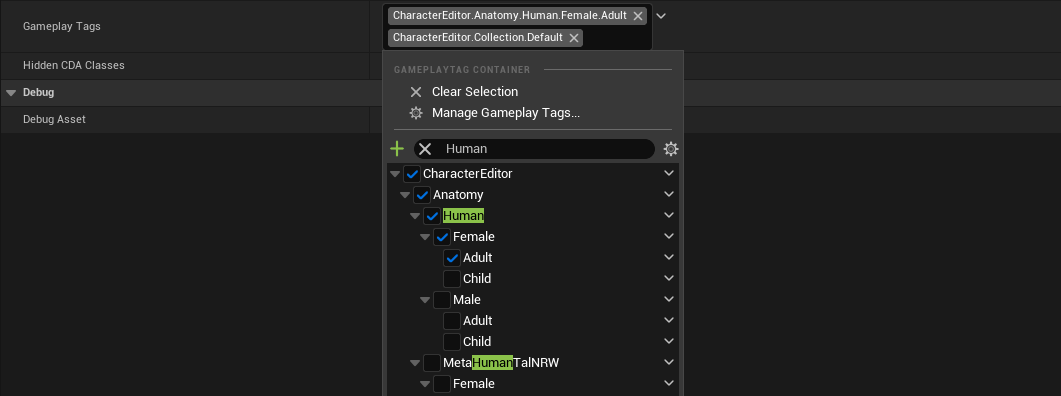
- This update replaces EAnatomy and E_CDA_Collection enumerations with Anatomy and Collection gameplay tags. This affects numerous Blueprints that deal with Customization Data Assets.
The BP_CharacterCustomization component and function libraries have been updated intensively to support the new Gameplay Tag system and provide additional features which were not possible or hard to achieve with the old Enumeration system.
The BP_CharacterEditor component does no longer handle CDA loading on its own, but waits for the results of the Package Registry. This gives you a single source of truth for CDA loading and avoids unnecessary widget creation and loops over already loaded CDA assets.
See Gameplay Tags for further details.
¶ BP_CustomizationDataAsset
Additions
- Added GameplayTags gameplay tag container that holds Anatomies and Collections.
Deprecations
- Deprecated Anatomies array.
- Deprecated Collections array.
¶ BP_CharacterCustomization
Additions
- Added managing functions.
- Get Available Anatomies
- Get Package Registry
- Set Package Registry
- Added more convenient and improved CDA randomization functions to replace the older ones.
- Randomize CDAs from Base Class (Replicable) in favor of Randomize CDAs (Replicable)
- Randomize CDA (Replicable) in favor of Set Random CDA Profile (Replicable)
- Added more convenient and improved CDA removal functions to replace the older ones.
- Remove CDAs from Base Class (Replicable) in favor of Remove All CDA Profiles (Replicable)
- Remove CDA (Replicable) in favor of Remove CDA Profile (Replicable)
- Remove Apparel (Replicable) in favor of RemoveAllCDA_ApparelProfiles (Replicable)
- Remove Attachments (Replicable) in favor of RemoveAllCDA_AttachmentProfiles (Replicable)
- Remove Equipment (Replicable) in favor of RemoveAllCDA_EquipmentProfiles (Replicable)
- Remove Groom (Replicable) in favor of RemoveAllCDA_GroomProfiles (Replicable)
- Remove Hairstyle (Replicable) in favor of RemoveAllCDA_HairstyleProfiles (Replicable)
Updates
- Updated several functions with a new Can Be Empty input to allow deselection with randomization.
- Randomize Apparel (Replicable)
- Randomize Attachments (Replicable)
- Randomize Equipment (Replicable)
- Randomize Groom (Replicable)
- Randomize Hairstyle (Replicable)
- Set Random CDA Apparel Profile (Replicable)
- Set Random CDA Attachments Profile (Replicable)
- Set Random CDA Equipment Profile (Replicable)
- Set Random CDA Groom Profile (Replicable)
- Set Random CDA Hairstyle Profile (Replicable)
Removals
- Removed old CDA randomization functions.
- Removed old CDA removal functions.
- Removed CDA function in favor of the new gameplay tags.
- Cleanup CDAs Except CDAs from Collection
- Removed the deprecated CDA cleanup part in randomization function.
- Set Random CDA Apparel Profile (Replicable)
- Set Random CDA Attachments Profile (Replicable)
- Set Random CDA Equipment Profile (Replicable)
- Set Random CDA Groom Profile (Replicable)
- Set Random CDA Hairstyle Profile (Replicable)
¶ BP_CharacterEditor
Additions
- Added Event Graph nodes to wait for the Package Registry to finish loading.
Removals
- Removed Event Graph nodes to spawn WBP_CDA_LoaderWidget to start and wait for loading.
¶ Character Editor Function Library
Additions
-
Added Character Editor | Utilities | Class
- Sort Class Array
-
Added Character Editor | Utilities | Customization | Anatomy
- Anatomy Array to String
- Break Anatomy Gameplay Tag
- Break Anatomy Gameplay Tags Hierarchical
- Get Anatomy from Anatomy Profile
- Get String from Anatomies
- Is Valid Anatomy Gameplay Tag
- Make Anatomy Gameplay Tag
- Map Anatomy Enum To Anatomy Gameplay Tag
- Validate Anatomy Gameplay Tag
-
Added Character Editor | Utilities | Customization | Collection
- Get String from Collections
- Is Valid Collection Gameplay Tag
- Validate Collection Gameplay Tag
-
Added Character Editor | Utilities | Customization | Customization Data Assets
- Break CDA Filter
- Cast Class Array to CDA Class Array
- CDA Class Array to CDA Set
- Get CDA Category Class
- Get CDA Mesh Display Name
- Get Friendly CDA Class Name
- Is CDA Matching Anatomy Filter
- Is CDA Matching Collection Filter
- Is CDA Matching Filter Settings
- Is CDA Mesh Valid
- Make CDA Filter
- Make CDA Filter From Single Anatomy
- Make CDA Filter From Single Anatomy and Collection
- Make CDA Filter From Single Collection
-
Added Character Editor | Utilities | Customization | Customization Profile
- Customization Profile Meta Data To String
- Customization Profile To String
- Is Customization Profile Meta Data Savable
- Is Customization Profile Meta Data Valid
-
Added Character Editor | Utilities | Gameplay Tags
- Exclude Gameplay Tags (opposite of filter variant)
- Exclude Child Gamplay Tags (opposite of filter variant)
- Filter Gameplay Tags
- Filter Child Gamplay Tags
- Get Next Gameplay Tag in Container
- Get Previous Gameplay Tag in Container
- Get Short String from Gameplay Tag
- Get Short String from Gameplay Tag Container
- Get Special Filter Gameplay Tags
- Get Special Filter Gameplay Tags Display Names
- Has Any Tags Vice Versa
- Is Gameplay Tag Container Empty
- Is Gameplay Tag Container Not Empty
- Matches Child Tag
- Matches Any Child Tags
- Sort Gameplay Tag Array
- Sort Gameplay Tag Container
-
Added Character Editor | Utilities | Operators
- Equal (==) CDA Apparel Profile
- Equal (==) CDA Attachment Profile
- Equal (==) CDA Equipment Profile
- Equal (==) CDA Groom Profile
- Equal (==) CDA Hairstyle Profile
- Equal (==) Customization Profile (by Meta Data)
- Equal (==) Customization Profile Meta Data
- Greater String String
- Lesser String String
- Near Equal (~==) HDR Color
- Not Equal (!=) CDA Apparel Profile
- Not Equal (!=) CDA Attachment Profile
- Not Equal (!=) CDA Equipment Profile
- Not Equal (!=) CDA Groom Profile
- Not Equal (!=) CDA Hairstyle Profile
- Not Equal (!=) Customization Profile (by Meta Data)
- Not Equal (!=) Customization Profile Meta Data
-
Added Character Editor | Utilities | Save Game
- Upgrade Save Game from V10 to V11
-
Added Character Editor | Utilities | String
- Sort String Array
- To Captial
-
Added Character Editor | Utilities | Text
- Join Text Array
- Remove Empty Items
Updates
- Updated version getter functions to V11.
- Updated Load Save Game to support BP_SaveGame_V11.
- Updated Get Friendly CDA Name to properly capitalize indivual words in CDA asset names.
Deprecations
- Deprecated the following functions in favor of Get All CDA Pickers.
- Get All CDA Apparel Pickers
- Get All CDA Groom Pickers
- Get All CDA Hairstyle Pickers
Removals
-
Removed Character Editor | Utilities | Customization | Customization Data Assets
- Does CDA Passes Filter Settings (enum version) in favor of Is CDA Matching Filter Settings.
- Filter Load CDA From Asset Data in favor of connecting the Package Registry to CDA Pickers.
- Print Customization Profile Meta Data in favor of Print Customization Profile.
-
Removed deprecated functions from early development stages.
- CED Gender to Gender
- Gender to CED Gender
- Sort CED by Display Name
¶ Character Editor Object Macros
Additions
- Added Character Editor | Utilities | New Value
- Set New Value Branch (CDA Attachment Profile)
- Set New Value Branch (CDA Equipment Profile)
- Set New Value Branch (Gameplay Tag)
- Set New Value Branch (Gameplay Tag Container)
- Added Character Editor | Utilities | Flow Control
- Branch by CDA Class
¶ INI Files
Additions
- Added CharacterEditorBase.ini with core gameplay tags for the system and default CDAs.
- Added CharacterEditor.ini with Anatomy and Collection gameplay tags for additional Polyphoria content.
- Referenced the base INI file in DefaultGameplayTags.ini.
¶ Save Games
Additions
- Added FCustomizationProfile_V11
- Added FCustomizationProfileMetaData_V11
- Added BP_CharacterCustomizationSaveGame_V11
¶ BP_Package
- Added Gameplay Tag Meta to store data tables of meta data related to Gameplay Tags.
¶ BP_PackageRegistry
Additions
- Added properties for loading:
- Loader Widget Class
- Loader Widget ZOrder
- Loader Widget
- Update Each N CDAs
- Added functions for loading:
- Get Is Loading
- Get Packages to Load Count
- Get Should Trigger Reload
- Added functions for gameplay tags:
- Get Available CDA Anatomy Tags
- Get Available CDA Collection Tags
- Get Available CDA Gameplay Tags
- Get Gameplay Tag Meta
- Get Gameplay Tag Meta as Default Struct
- Get Gameplay Tag Meta Display Names
- Added Unique CDA Classes e.g., for the CDA Manager filter settings.
- Added Add Empty CDA input to Get CDAs by Class to support deselection.
Updates
- Updated Event Graph:
- Overhauled the loading flow to prevent unnecessary loading cycles.
- Use Loader Widget when triggering Initialize After Begin Play.
- This minimizes overhead when multiple characters loading in the level, by replacing the old individual loading widgets of BP_CharacterEditor. This loading method uses Update Each N CDAs to optionally adjust UI udpate frequency (see property description in engine).
- Added validation for empty packages (that you may be just creating).
- Added debug messages.
- Updated available delegates:
- Packages:
- OnStartLoading_AllPackageMetaData replaces OnStartLoading
- OnLoaded_SinglePackageMetaData replaces OnLoaded_PackageMetaData
- OnLoaded_AllPackageMetaData replaces OnLoadedAllMetaData
- Customization Data Assets:
- OnStartLoading_AllCDAs added
- OnLoaded_SingleCDA replaces OnLoadedSingleCDA
- OnLoaded_PackageCDAs replaces OnLoadedPackageCDAs
- OnLoaded_AllCDAs replaces OnLoadedAllCDAs
- Packages:
¶ Other Related Changes
Additions
- Added DT_AnatomyEnumGameplayTagMap and its structure to map CDAs and Customization Profiles.
- Added DT_CollectionEnumGameplayTagMap and its structure to map CDAs.
- Added DT_GameplayTagMeta_Default and its structure for the gameplay tag display names.
- Added similar data tables for all Polyphoria content packs.
- Added BP_GameplayTagTester to test some utility functions used by the gameplay tag system.
Updates
- Updated PKG_CharacterParts... files to use the new DT_GameplayTagMeta... data tables.
- Updated many other Base and Standalone Demo Blueprints to the new Customization Profile and Gameplay Tags.
Deprecations
- Deprecated EAnatomy enum.
- Deprecated E_CDA_Collection enum.
¶ Character Editor Tools
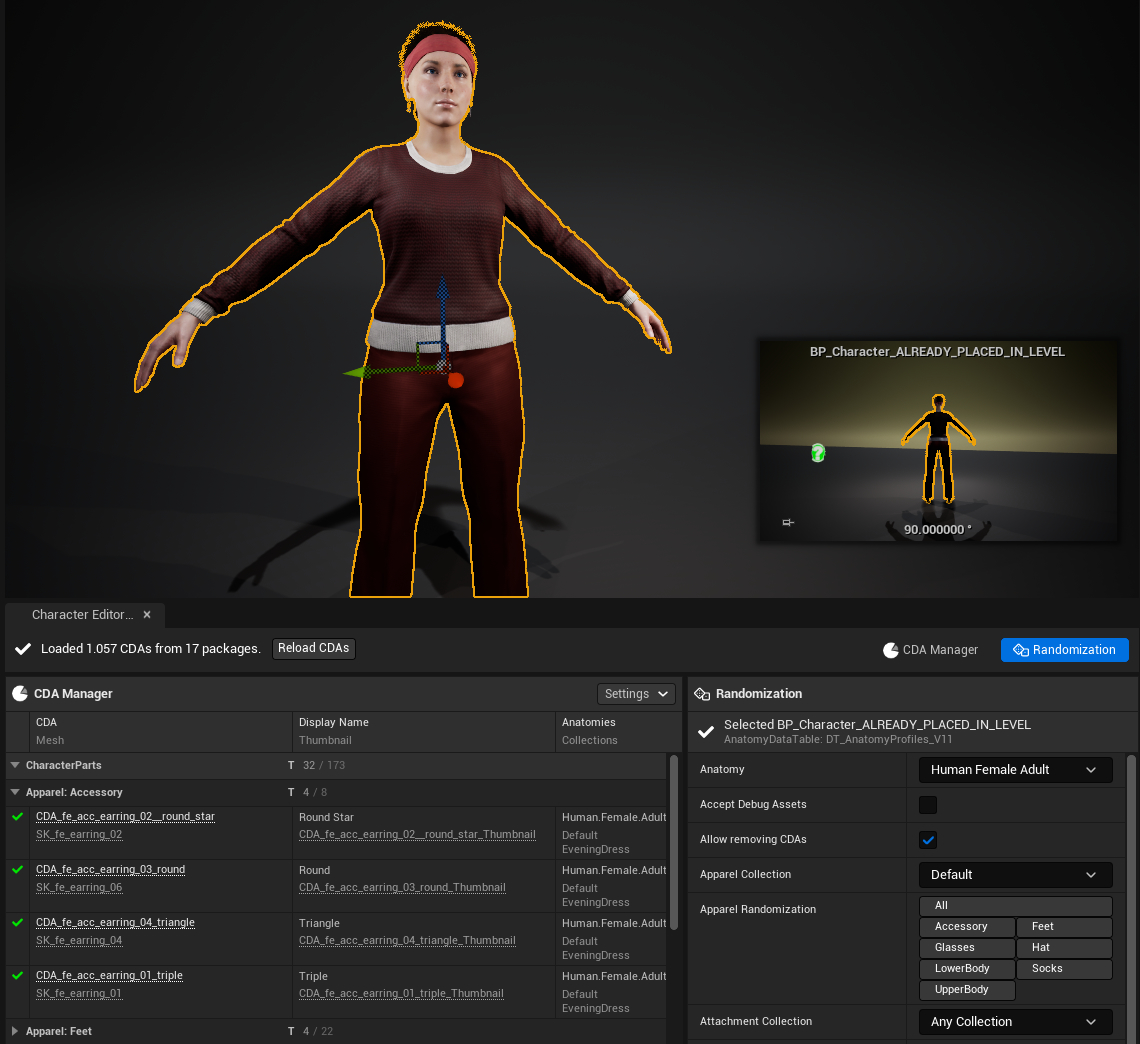
- The Character Editor Tools have been redesigned with a new CDA Manager and improved Randomization.
The CDA Manager validates and migrates Customization Data Assets. It provides various filters and settings to navigate your CDAs at a centralized place and find potential issues with their most important settings, easily.
The Randomization feature got a more dynamic approach to initialize its UI, allowing to randomize only available CDAs based on the selected pawn's anatomy and collections for each CDA base class.
See Character Editor Tools and Getting Started ➝ Character Editor V11 - Upgrade from V10 for further details.
¶ Character Editor Tools (Editor Utility Widget)
Additions
- Added new CDA Manager tab. (see below)
- Added updated Randomization tab. (see below)
Updates
- Renamed EUW_CharacterEditorTools widget to CharacterEditorTools.
- Improved the visuals to better match the Unreal Editor UI.
- Improved the CDA loading procedure by using the WBP_CDA_Loader_CharacterEditorTools.
¶ Character Editor Tools: CDA Manager
Additions
- Added validation objects.
- E_CDA_Validation
- FCDA_ValidationResult
- Added data objects to hold info for the tree view rows.
- BP_CDA_Manager_CDA_DataObject
- BP_CDA_Manager_ClassDataObject
- BP_CDA_Manager_PackageDataObject
- Added a tree view.
- CharacterEditorTools_CDA_Manager_CDA_Row_Tree
- FTreeViewChildrenMap
- Added filter and settings menus.
- CharacterEditorTools_CDA_Manager_FilterMenu
- CharacterEditorTools_CDA_Manager_FilterCDA_ClassesMenu
- CharacterEditorTools_CDA_Manager_FilterCDA_GameplayTagsMenu
- CharacterEditorTools_CDA_Manager_SettingsMenu_Default
- CharacterEditorTools_CDA_Manager_SettingsMenu_ForRND
- ECDA_ManagerExpansionType
- ECDA_ManagerSettingsCheckboxType
- FCDA_ParentClassesInfo
- MenuHeader
- Added meta data objects for checkboxes and combo-boxes.
- BP_ClassCheckboxMetaData
- BP_GameplayTagComboBoxMetaData
- BP_GamplayTagCheckboxMetaData
- BP_VerbosityCheckboxMetaData
- Added a save game file to persist filters and settings across Unreal Engine sessions.
- BP_CharacterEditorToolsSaveGame
¶ Character Editor Tools: Randomization
Additions
- Added info about the AnatomyDataTable in use by the selected pawn.
- Added DetailsEntry widget to display settings similar to Unreal Engine, but without column resizing.
- Added WBP_GameplayTagComboBox to select Anatomies and Collections.
- Added ApplyRemoveButton as a base for RandomizeButton and to apply or remove individual CDAs.
- Added Allow removing CDAs to the randomization options.
- Added Attachments, Equipment and Groom to the randomization options.
- Added determination logic to display required options, depending on the selected anatomy and CDA collections.
- Added a compact and readonly version of the CDA Manager to display the CDAs considered for randomization.
Updates
- Update Selected Pawn triggers Selected Pawn ➝ Construction Script based on Tags array.
¶ Character Editor Tools Function Library
Additions
- Added this function library for the Character Editor Tools.
- Added Character Editor Tools | Utilities | Save Game
- Load Character Editor Tools Save Game
- Save Character Editor Tools Save Game
- Added Character Editor Tools | Utilities | CDA Manager
- Checked CDA Class to Check Box State
- Checked Gameplay TagToCheck Box State
- Find CDA Parent Classes Info of CDA Class
- Get CDA Classes Parent Indents
- Get CDA Classes Parent Classes
- Is CDA Visible by Checked Filters
- Is CDA Visible by Checked Gameplay Tags
- Is CDA Visible for Randomization
- Is Parent of CDA Class Checked
- Update CDA Manager Gameplay Tag Columns
¶ Widget Blueprints
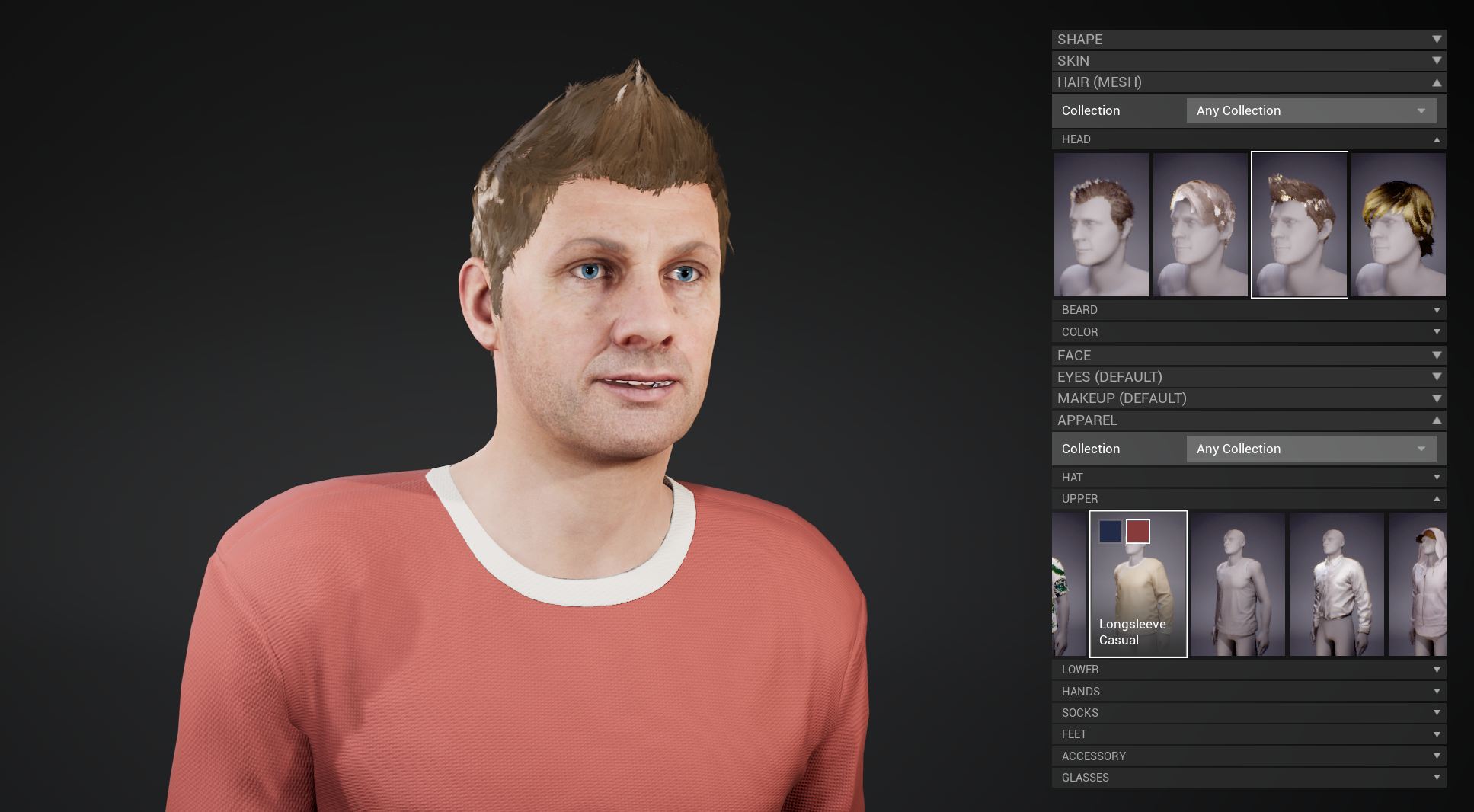
- The CDA Picker uses a new abstraction layer that provides you with all the functionality to easily inherit your custom CDA pickers. This improves rendering performance and makes it more streamlined to initialize CDA pickers, as well.
The CDA Loader also uses a new abstraction layer similar to the CDA Picker for custom CDA Loader widgets. By default, they are used by Package Registry and Character Editor Tools.
The Profile Manager got a new abstraction layer as well, to inherit custom Profile Managers. By default, they are used by WBP_CharacterEditor and WBP_CharacterEditor_ForProfileSelection.
The CDA Collection Picker now uses the new WBP_GameplayTagComboBox to select actual gameplay tags rather than enum values. Furthermore, it stores selected collections per anatomy by itself - previously WBP_CharacterEditor did it. This makes it more streamlined to re-initialize collection pickers when the character anatomy changes.
The Expandable Category was slightly refactored to perform its randomization setup internally instead of inside WBP_CharacterEditor.
And finally, the different Character Editor widgets use the changes mentioned above.
¶ CDA Picker
Additions
- Added WBP_CDA_PickerBase as a base for the whole picker.
- Added WBP_CDA_PickerItemBase as a base for individual CDA items.
- Added WBP_CDA_Picker_DefaultStyle as the default implementation for whole pickers.
- Added WBP_CDA_PickerItem_DefaultStyle as the default implementation for individual CDA items.
- Added BP_CDA_PickerItemObject to handle data and selection.
- Added E_CDA_PickerDeselectionBehavior to configure deselection.
Deprecations
- Deprecated old specific CDA pickers and items
- WBP_CDA_ApparelPicker
- WBP_CDA_ApparelPicker_MainButton
- WBP_CDA_GroomPicker
- WBP_CDA_GroomPicker_MainButton
- WBP_CDA_HairstylePicker
- WBP_CDA_HairstylePicker_MainButton
¶ CDA Collection Picker
Additions
-
Added new properties for the Package Registry:
- Character Customization
- CDA Class
-
Added new properties for the self-storage of collections:
- Anatomy
- Selected Collections Per Anatomy
-
Added new properties to make the CDA Collection Picker more customizable:
- Show Collection Any
- Show Collection None
- Accept Debug Assets
-
Added Reinitalize to easily update the CDA Collection Picker after an Anatomy change.
-
Added WBP_GameplayTagComboBox to select a gameplay tag.
-
Added BP_GameplayTagComboBoxMetaData to distinguish comboboxes by their CDA Class.
Updates
- Replaced ComboBox with GameplayTagComboBox.
- Replaced Value with Collection.
- Replaced Default Value with Default Collection.
- Replaced Hidden Collections with Hidden Collections.
- Updated Initialize to conditionally show "Any" and "None" options above actual Collection options.
- Updated Initialize to fallback to the first available collection rather than "Any" (in case it is not present).
- Updated On Value Changed to pass CDA Class, Anatomy, and Collection.
- On Value Changed does not get called during initialization, anymore.
¶ CDA Loader
Additions
- Added the base Widget Blueprint
- WBP_CDA_LoaderBase
- Added the specific implementations
- WBP_CDA_Loader_DefaultStyle for Package Registry
- WBP_CDA_Loader_CharacterEditorTools for Character Editor Tools
Removals
- Replaced WBP_CDA_Loader with WBP_CDA_Loader_DefaultStyle
¶ Profile Manager
Additions
- Added WBP_ProfileManagerBase with various functionality.
- Profile Manager | Profiles
- Can Be Saved
- Delete Profile
- Load Profile
- Save Selected Profile
- Profile Manager | Profiles (Protected)
- Set Selected Profile
- Set Selected Profile Name
- Profile Manager | Race
- Select Next Race
- Select Previous Race
- Profile Manager | Race (Protected)
- Set Selected Race
- Profile Manager | Gender
- Select Next Gender
- Select Previous Gender
- Profile Manager | Gender (Protected)
- Set Selected Gender
- Update Available Genders
- Profile Manager | Generation
- Select Next Generation
- Select Previous Generation
- Profile Manager | Generation (Protected)
- Set Selected Generation
- Update Available Generations
- Profile Manager | Anatomy (Protected)
- Update Selected Anatomy
- Profile Manager
- Initialize
- Post Initialize
- Reinitialize
- Update Visuals
- Profile Manager | Profiles
Updates
- Refactored the existing profile managers to use the new base as their parent class including the new implementation details.
- WBP_ProfileManager
- WBP_CE_Demo_ProfileManager_ForProfileSelection
¶ Expandable Category
Additions
- Added Initialize Randomization
Updates
- Made variables private, as they are controlled internally:
- Can Be Expanded
- Can Be Randomized
Fixes
- Fixed a bug that selected CDAs from hidden categories on randomization.
¶ Character Editor
Additions
- Added the updated Widget Blueprints and logic changes to the different existing character editors.
- WBP_CharacterEditor
- WBP_CE_Demo_CharacterEditor_ForProfileSelection
- WBP_CE_Demo_CharacterEditor_ForGenderSelection
- WBP_CE_Demo_CharacterEditor_ForCustomization
Updates
- Replaced the deprecated CDA pickers with WBP_CDA_Picker_DefaultStyle
- Renamed Initialize CDA Pickers to Initialize - CDA Pickers And CDA Collection Pickers and added changes required by WBP_CDA_PickerBase and WBP_CDA_CollectionPicker.
- Renamed Bind on Randomize... to Initialize - Randomization ... and cleaned up its content by using the new Initialize Randomization of WBP_ExpandableCategory.
- Improved Initialize - Profile Manager ... by adding changes required by WBP_ProfileManagerBase.
Removals
- Made the unsupported facial morph widgets hidden when using Meta Humans.
¶ Meta Humans
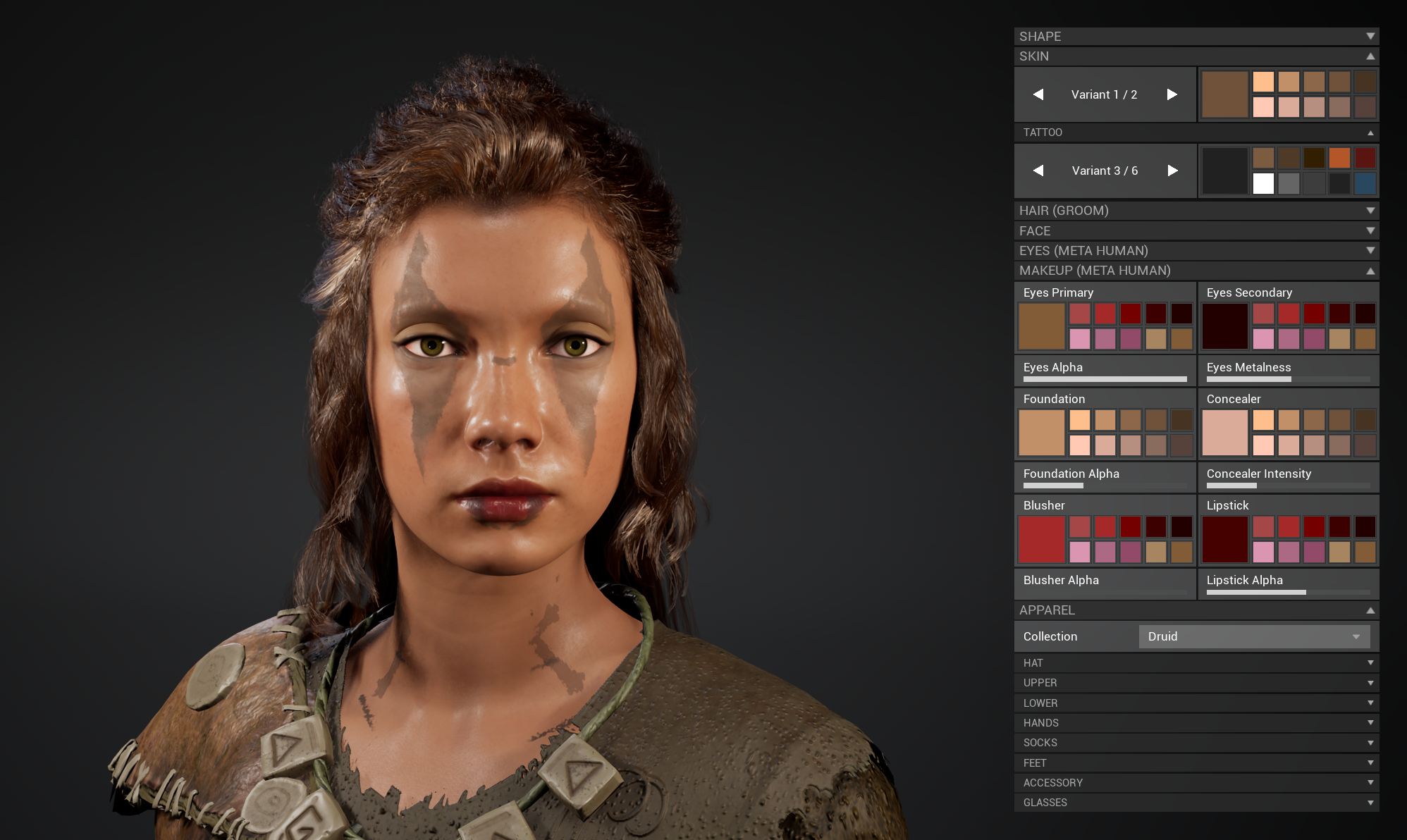
-
The Meta Humans finally received our general support for makeup1 and optional support for skin tint and tattoos2, which previously had to be implemented completely by yourself! Besides that, we made face morphs hidden, while using Meta Humans, as they are not supported, which caused confusion.
Meta Humans are not part of this product due to Fab seller guidelines. You can manually add them by following the Third Party Integration: Meta Humans tutorial.
1) The makeup widgets only work in UE 5.4 and UE 5.5, because Meta Human materials do not include makeup parameters since UE 5.6.0, anymore. We hope, this will change in future releases.
2) Optional support means, that the required materials for skin tint and tattoos can be downloaded for free from the link above due to the same restrictions, as for the whole Meta Humans themselves. Unfortunately, providing them to you as "demo content" would result in broken references. Skin Tint and Tattoos work in all Engine versions. See V11 Gameplay Tag Update: Skin Tint, Tattoos & Makeup for details.
¶ WBP_CharacterEditor
Additions
- Added native support for makeup when using Meta Human materials.
- Added documentation to Update Anatomy Specific Controls.
Updates
- Made unsupported facial morph widgets hidden when selecting the Meta Human anatomy.
¶ Materials
Additions
- Added skin tint and tattoos to M_BodySkin and M_Head_Baked. (to be downloaded as mentioned)
- Added material function to simplify skin tint and tattoos in Meta Human materials.
- MF_RGBA_Tint_Skin_MetaHuman (all Unreal Engine versions)
- MF_Tattoo_MetaHuman_UE54 (Unreal Engine 5.4 and 5.5)
- MF_Tattoo_MetaHuman_UE56 (Unreal Engine 5.6)
¶ DT_AnatomyProfiles_V11
Updates
- Updated the Skin Material Sets ➝ Head slots to apply the skin material to all Meta Human LODs.
- head_shader_shader (already existed; LOD0)
- head_LOD1_shader_shader (new)
- head_LOD2_shader_shader (new)
- head_LOD3_shader_shader (new)
- head_LOD4_shader_shader (new)
- head_LOD57_shader_shader (new; LOD5 to LOD7)
¶ Pawn-based Customization
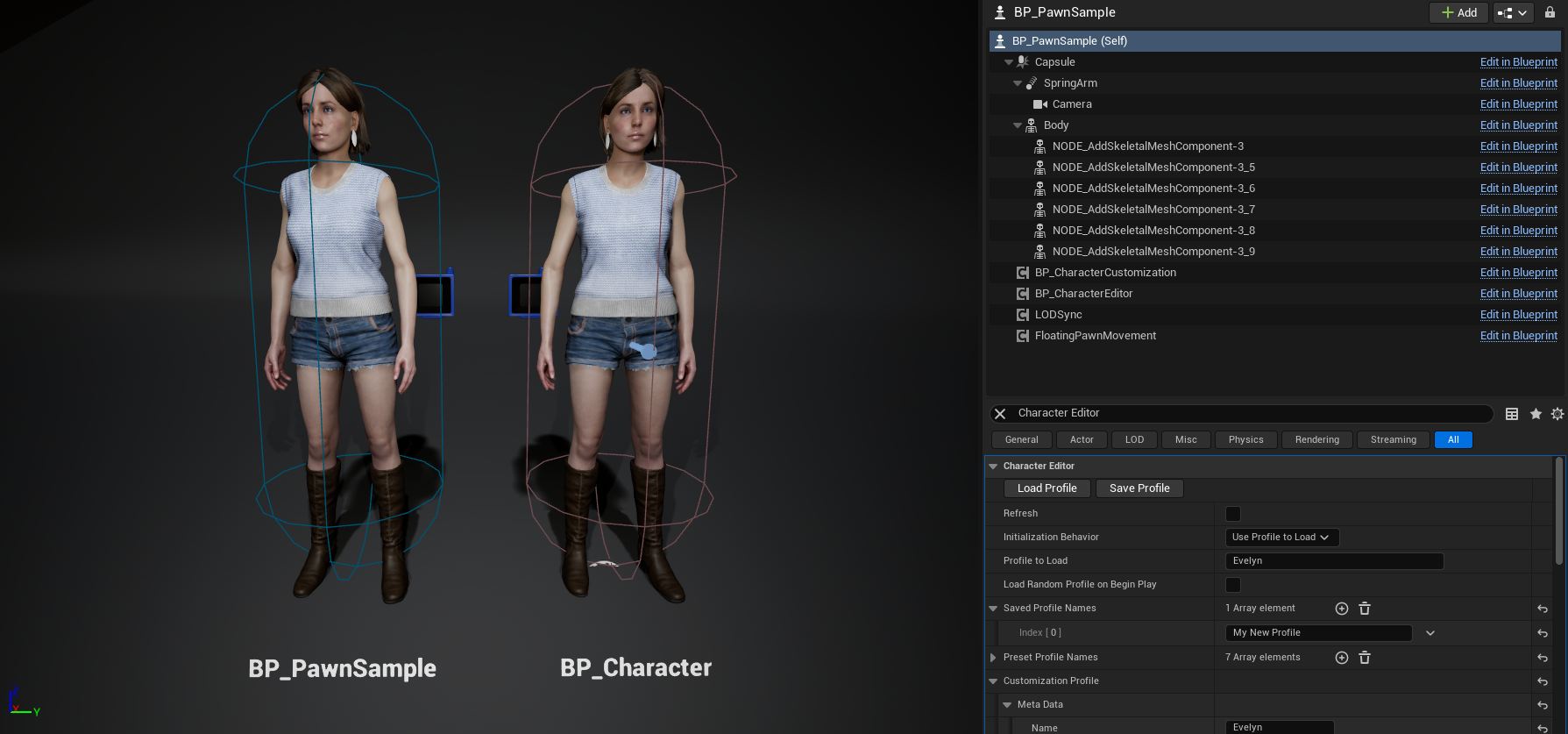
- The Character Editor can finally be used with Pawn-based, instead of just Character-based Blueprints.
To use it in your Blueprint, there is a new Get Basebody Body Component in the Character Customization Interface for your character Blueprint which must return your desired main skeletal mesh component on Pawn-based Blueprints or Mesh (CharacterMesh0) on Character-based Blueprints.
See BP_PawnSample as a demo reference, it is quite similar to BP_Character.
¶ BP_CharacterCustomization
Additions
- Added validation functions and macros for the new Owning Pawn.
- Get Validated Owning Pawn in favor of Get Validated Character
- Get Validated Owning Player Id in favor of Get Validated Player Id
- Validate Owning Pawn Dependencies in favor of Validate Character
- Added functions for the improved customization profile fallback logic.
- Get Fallback Customization Profile
- Get Current Anatomy Default Customization Profile
- Added BP_PawnSample as a demo reference.
Updates
- Updated Get Basebody Body Component to get the component from the Owning Pawn via the Character Customization Interface instead of the static Character ➝ Mesh.
Removals
- Removed old validation functions.
- Removed Get Validated Basebody Body Component in favor of Get Basebody Body Component.
¶ BP_CharacterEditor
Additions
- Added validation functions and macros for the new Owning Pawn logic.
- Get Validated Owning Pawn in favor of Get Validated Character
- Get Validated Owning Player Id in favor of Get Validated Player Id
Removals
- Removed old validation functions.
¶ BP_Character
Additions
- Implemented Get Basebody Body Component from Character Customization Interface.
¶ Character Customization Interface
Additions
- Added Get Basebody Body Component.
¶ Other Related Changes
Updated
- Updated several other Base and Standalone Demo Blueprints (e.g. BP_SelectionManager) to replace Character references with Pawn references.
¶ Multiplayer
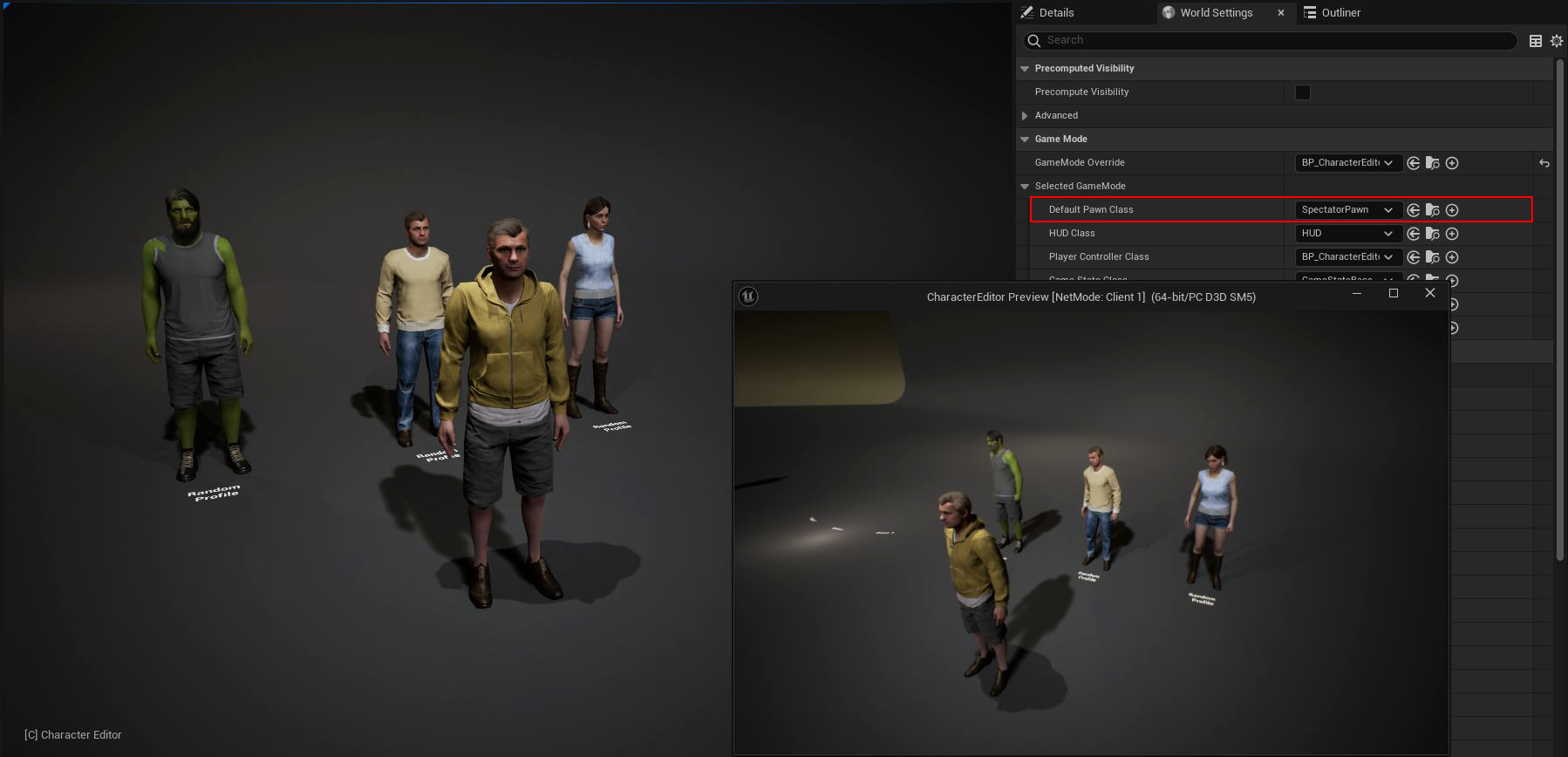
- There has already been a feature that replicates Customization Profiles in Dedicated Server or Listen Server scenarios to synchronize joining clients with pawns, using BP_CharacterCustomization, that have already been initialized and applied their Customization Profile, before the client joined.
Since the feature did not work for joining pawns, which did not use the BP_CharacterCustomization component themselves, the feature has been moved to the new BP_CharacterCustomization_Controller component, that can be added pawn-independently to any Controller-based Blueprint that is your pawns' player controller class. It simply handles that feature: requesting Customiztion Profiles.
The screenshot above shows a default SpectatorPawn without any customization component, as an example pawn joining as Client 1 that get all ohter customizations replicated as it should be.
Besides that, we fixed a few minor replication bugs with NPCs and apparel settings.
See BP_CharacterCustomization_Controller for further details.
¶ BP_CharacterCustomization
Additions
- Added Initialization ➝ Server_SendCurrentCustomizationProfileToPlayer to replace the old logic.
Fixes
- Fixed Initialization was not always initializing NPCs correctly in multiplayer.
Removals
- Removed Event Graph ➝ Server_RequestCustomizationProfilesForOtherCharacters.
- Removed Event Graph ➝ Server_SendRequestedCustomizationProfile.
¶ BP_CharacterCustomization_Controller [V11]
Additions
- Added this new Actor component.
- Added Event Graph ➝ RequestCustomizationProfilesFromOtherPawns.
- Added Event Graph ➝ Server_RequestCustomizationProfilesFromOtherPawns.
- Added Blueprint description.
¶ BP_CharacterEditorPlayerController [V11]
Additions
- Added this new Player Controller Blueprint.
- Added BP_CharacterCustomization_Controller component to this Blueprint.
- Assigned this Blueprint to BP_CharacterEditorGameMode ➝ Player Controller Class.
¶ BP_Character
Fixes
- Fixed replication warnings for apparel settings in multiplayer.
¶ Chores & Other Improvements
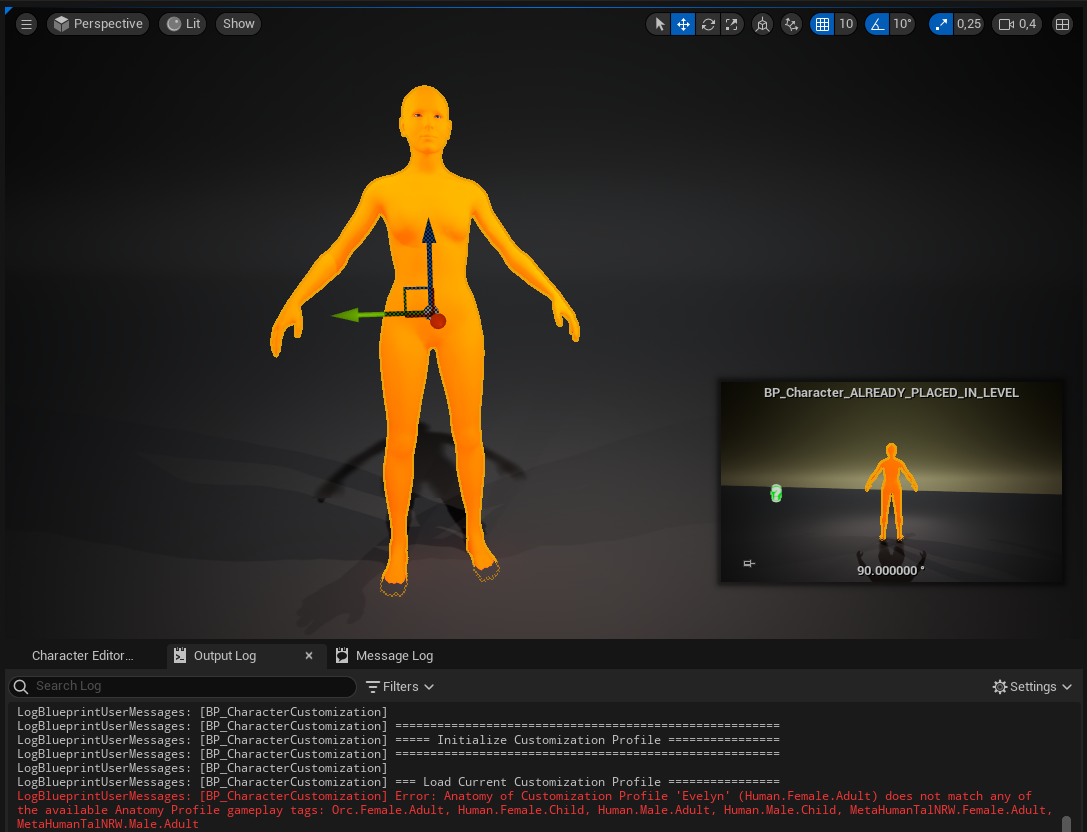
- To complement the before-mentioned content features, more validation and debug info has been added. Besides that, Blueprints and functions got more descriptions, and some fixes & cleanup happened.
¶ BP_CharacterCustomization
Additions
- Added validation macros:
- Validate Customization Profile
- Validate Customization Profile Meta Data for Saving
- Added M_FallbackAnatomyProfile material to FallbackAnatomyProfile.
- Added Blueprint description.
Updates
- Improved Update Available Anatomy Profiles:
- Simplified the data table validation (you are no longer required to have the version number in its name).
- Extended the validation of each invidivual Anatomy Profile in the table to log more detailed warnings.
- Added a final validation error, if there are no Anatomy Profiles processed successfully at all.
- Added logging the profiles' anatomy.
- Improved Update Preset Customization Profiles:
- Simplified the data table validation (you are no longer required to have the version number in its name).
- Extended the validation of each invidivual Preset Customization Profile in the table to log more detailed warnings.
- Added logging the profiles' anatomy.
- Improved Update Saved Customization Profiles:
- Added logging the profiles' anatomy.
- Updated Initialize from Character Begin Play to simplify its Package Registry initialization.
- Updated functions to use the fallback Customization Profile if their state or input is invalid.
- Initialize Customization Profile
- Apply Customization Profile
- Load Current Customization Profile
- Load Preset Customization Profile
- Load Saved Customization Profile
- Updated functions with new or adjusted debug info.
- Update Basebody
- Update Basebody Body
- Update Basebody Head
- Update Cached Customization Profiles
- Update Skin Materials
- Add CDA Groom
- Add CDA Skeletal
- Add CDA Static
- Devided Event Graph into multiple event graphs to improve Blueprint editing performance.
- Initialization
- Anatomy
- MorphTargets
- AnimInstanceAlpha
- Skin
- Eyes
- Owner
- SetCDAs
- GlobalHDR_VectorParameters
- GlobalScalarParameters
Fixes
- Fixed Update Eyes Materials was not always properly creating MIDs.
- Fixed setting and removing individual CDAs were not updating morph targets, properly.
¶ BP_CharacterEditor
Additions
- Added Light Studio Profiles Handle to select a custom data table for your Light Studio.
- Added z-order properties for more control when using other widgets simultaneously to the Character Editor.
- Character Editor Widget ZOrder
- Idle Widget ZOrder
- Added Event End Play that destroys existing Camera Studio, Light Studio, Idle Widget, and Character Editor Widget when the component is destroyed.
- Added Blueprint description.
Updates
- Updated Create Widget to accept the new z-order properties.
- Updated several places with new or adjusted debug info.
- Event Graph
- Use or Spawn Actor
- Find or Spawn and Initialize Camera Studio
- Find or Spawn and Initialize Light Studio
- Create Widget
¶ BP_PackageRegistry
Additions
- Added Debug Mode similar to the one in BP_CharacterCustomization.
- Added debug macros:
- Debug
- Debug Error
- Debug Warning
- Debug Information
- Debug Detailed Information
- Debug Verbose Information
¶ Character Editor Function Libraries
Additions
- Added Character Editor | Utilities | Debug (which are used in several print macros)
- Print Error
- Print Error (With Empty Line)
- Print Error Incorrect CDA Class
- Print Customization Profile
- Print Warning
- Print Warning (With Empty Line)
¶ Character Editor Object Macros
Additions
- Added Character Editor | Utilities | Array
- Get Next Array Index (Looping)
- Get Previous Array Index (Looping)
Fixes
- Fixed Validated Get to return a proper default value, if the index is not valid. Before this fix, it always returned the last valid value, if the index has been valid at least once.
¶ BP_CE_Demo_CharacterBase_CC & BP_CE_Demo_CharacterBase_CC_CE
Additions
- Added LODSync component while enforcing LOD 0 on BP_CC_Demo_CharacterBase_CC_CE.
¶ BP_CE_DemoCharacter_ForGameWorld && BP_SelectionManager
Additions
- Added error messages that inform you, if the required demo Game Instance is not used.
¶ WBP_LightSettings
Additions
- Added Light Studio Profiles Table to select a custom data table that populates the profiles list.
¶ Documentation Changes
- The Wiki received several content changes to reflect the change log information from above as mentioned below.
Futhermore, a new shiny look & feel has been added to make it easier for you to spot connections between text and logic - mostly the same pages are updated that received content changes, the rest will follow, gradually.
¶ Content Changes
Additions
- General:
- Using the Blueprints:
- Using the Character Editor:
Updates
- Using the Blueprints:
- BP_CharacterCustomization - Applying customizations to your Pawn Blueprint
- BP_CharacterEditor - Using the in-game editor Widget Blueprints
- Anatomies - Defining visual appearance of a basebody
- Former page name: "Anatomy Profile"
- Collections - Defining sets of Customization Data Assets
- Customization Data Assets - Defining character parts for Customization Profiles
- Customization Profile - Storing structured customization settings
- Package Registry - Loading and managing CDAs
- Using the Character Editor:
- Tutorials:
- Persist Customization Profiles for packaging
- Former page name: "Add Customization Profiles and spawn Characters with them applied")
- Third Party Integration: Meta Humans
- Persist Customization Profiles for packaging
Deprecations
¶ Look & Feel
Additions
- Added general identifiers:
- Asset
- Class
- Value
- Added flow identifiers:
- Graph
- Event
- Function
- Pure function
- Macro
- Delegate
- Added variable identifiers
- Boolean
- Byte
- Int
- Int64
- Float
- Name
- String
- Text
- Vector
- Rotator
- Transform
- Object
- Class
- Soft Object
- Soft Class
- Interface
- Delegate
- Gameplay Tag
- Gameplay Tag Container
- Struct
- Wildcard
Updates
-
Tinted info blockquotes blue to reduce the warning feeling:
Lorem ipsum dolor sit amet, consetetur sadipscing elitr.
¶ V10 Selection Update
Introduction
This update brings the assets of our latest demo application, new skin texture sets (e.g. for tattoos), a more customizable BP_CharacterEditor component, a networking adjustment for slower client connections, and a few bug fixes.
As a friendly reminder: Since [V6] Replication Update, please prefer using events and functions with
(Replicable)in their names over their similar events and functions without that name extension to use network replication, correctly, unless you build some very custom logic.
With that being said, let's kick off the news!
¶ Character Editor V10 Demo
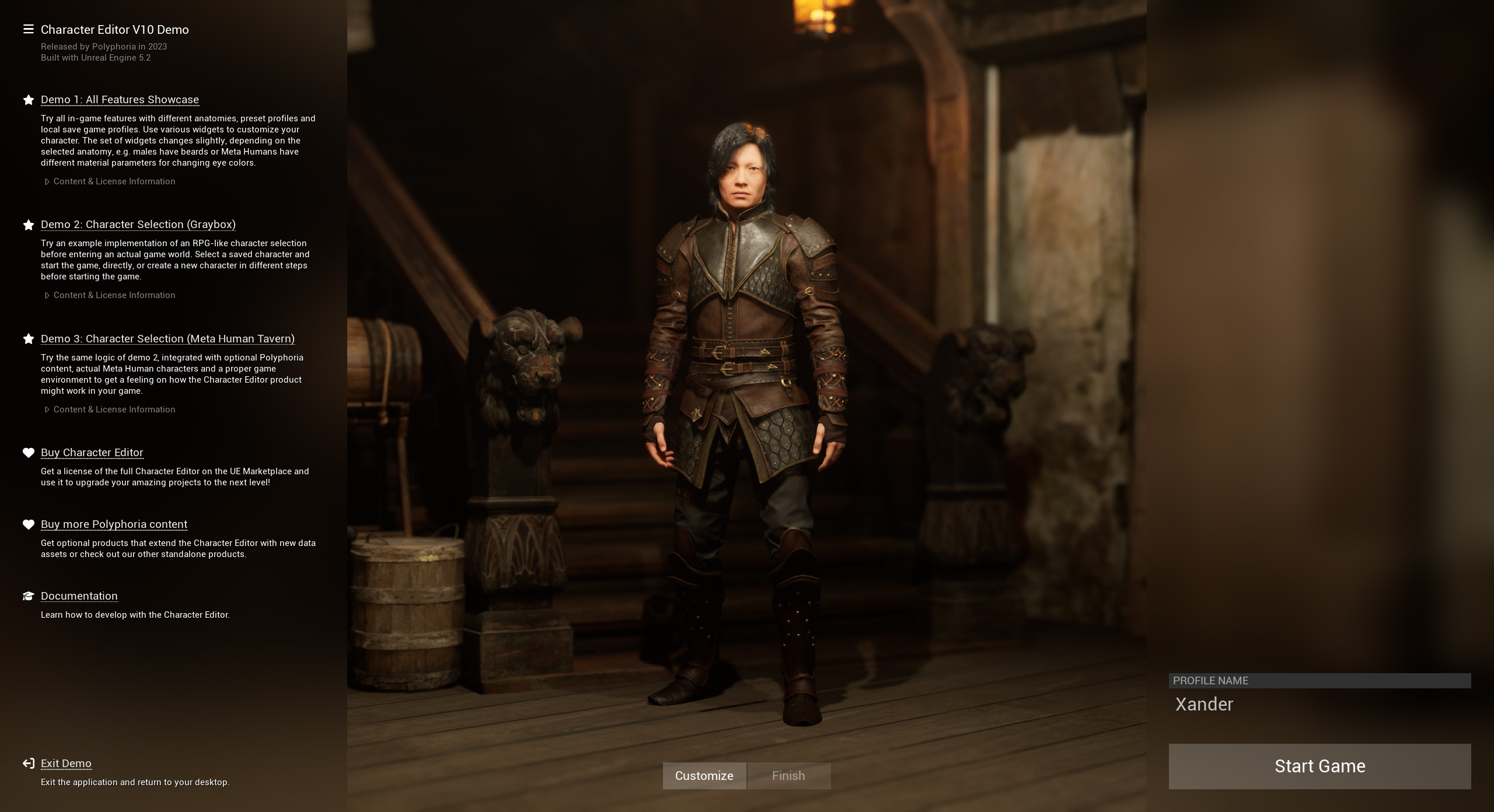
- [Highlight] We have created a standalone demo!
Feel free to evaluate the major aspects of the Character Editor before hopefully joining our community!
The demo application is devided into 3 different singleplayer sub-demos, that showcase basic and advanced implementations. When purchasing the Character Editor, you get the full content of demo 1 and demo 2. Though, demo 3 is for showcasing only and not available through the marketplace.
See more details on how to download and use the demo on the Character Editor V10 Demo page.
- [Added] Added a new folder
CharacterEditor\StandaloneDemocontaining the logic of sub-demo 2 and 3. See more details on how to use the logic on the Standalone Demo page.
¶ Skin Texture Sets (Tattoos, Scars, etc.)
- [Highlight] With this version of the data table and its structures, you can manage Skin Texture Sets to display UV-space tattoos, scars, freckles, dirt, and other skin additions you may need. As an example, we have implemented tattoos.
¶ New Anatomy Profile V10

-
[Added] Added
FAnatomyBodyProfile_V10Skin Texture Setsstores a named list of skin texture sets, where the name is referenced inFSkinProfile_V10. TheBodyandHeadtexture sets can contain an arbitrary set of named textures, where the name is used to apply a texture parameter in the currently active basebody skin material. The material must contain the texture parameters with the identical names, spaces included. The actual look of the tattoo and other parameters like color are up to the material implementation.
-
[Added] Added
FAnatomyHeadProfile_V10Skin Texture Sets (Overrides)stores a similar list as above, but only for the head. The texture sets are merged, e.g. ifFAnatomyBodyProfile_V10defines the setsTattoo_01toTattoo_05, the overrides could only overrideTattoo_03andTattoo_04.
-
[Added] Added
DT_AnatomyProfiles_V10data table
¶ New Customization Profile V10

-
[Added] Added
FSkinProfile_V10and corresponding structures.Skin>Texture Setsstores names of the selected texture sets. It is meant to store one type ("Tattoo", "Scar", etc.) at a time, thus there cannot be bothTattoo_01andTattoo_02. Since the material on the basebody has to support that texture set anyways, you could use different keys for multiple tattoos, e.g.Tattoo_A_01,Tattoo_B_01.
-
[Added] Added
DT_CustomizationProfiles_V10data table
¶ Changes to BP_CharacterCustomizaton
- [Added] Function
GetCurrentSkinTextureSetsgets the texture sets that are currently selected. - [Added] Function
GetCurrentAnatomySkinTextureSets (BodyAndSelectedHead)gets all texture sets defined in the anatomy data table for the currently selected anatomy. This includes body and head textures by default, possibly overridden by head textures if defined in DT_AnatomyProfiles. - [Added] Function
SetSkinTextureSetssets the currently selected texture sets. - [Added] Function
SetSkinTextureSetsByKey (Replicable)sets a single texture set with a given key, e.g. "Tattoo", "Scar", etc. Calls eventSetSkinTextureSets (Replicable). - [Added] Function
UpdateSkinTextureSetsremoves old textures and applies the currently selected textures onto skin body and skin head MIDs. - [Added] Event
SetSkinTextureSets (Replicable)and corresponding to replicate functionSetSkinTextureSets. - [Added] Dispatcher
OnSet_SkinTextureSetsreturns the applied texture sets. It is called bySetSkinTextureSets. - [Added] Dispatcher
OnUpdated_SkinTextureSetsreturns the applied texture sets. It is called byUpdateSkinTextureSets. - [Added] Event
ApplyCustomizationProfile (NextTickActions)executesUpdateGroomone tick delays, as we noticed heavily broken Groom visuals after loading into a level with streaming levels included. This event is called from functionApplyCustomizationProfile.
-
[Updated] Refactored some functions. Some functions got renamed to better declare the expected return value.
(SelectedHead)returns selected head info from DT_AnatomyProfiles,(BodyOrSelectedHead)returns either body or head info, and(BodyAndSelectedHead)merges data partially. Some functions have been made impure, so they do not have to run their more complex filter logic repeatedly if their output is accessed multiple times. Some functions have different logic.-
GetCurrentAnatomyHeadAnimInstanceClass(pure)
GetCurrentAnatomyHeadAnimInstanceClass (SelectedHead)(impure) -
GetCurrentAnatomyHeadMesh(pure)
GetCurrentAnatomyHeadMesh (SelectedHead)(impure) -
GetCurrentAnatomyHeadProfile (Selected)(pure)
GetCurrentAnatomyHeadProfile (SelectedHead)(impure) -
GetCurrentAnatomyBodyAnimInstanceClass(pure)
GetCurrentAnatomyBodyAnimInstanceClass (SelectedHead)(impure) -
GetCurrentFaceVariants(pure)
GetCurrentAnatomyFaceVariants (BodyOrSelectedHead)(impure) -
GetCurrentAnatomyBodyAnimInstanceClass(pure)
GetCurrentAnatomyEyesMaterialSets (BodyAndSelectedHead)(impure) -
GetCurrentAnatomyBodyAnimInstanceClass(pure)
GetCurrentAnatomySkinMaterialSets (BodyAndSelectedHead)(impure) -
GetCurrentAnatomyBodyAnimInstanceClass(pure)
GetCurrentAnatomySkinTextureSets (BodyAndSelectedHead)(impure) -
GetCurrentSkinMaterialSets(pure)
GetCurrentSkinMaterialSet(impure)
This function does not simply get all anatomy body skin material sets anymore, but the currently selected set (body and head) based onGetCurrentAnatomySkinMaterialSets (BodyAndSelectedHead)and the currentSkin Profile>Material Index -
GetCurrentEyesMaterialSet(impure)
This function gets the eyes material set based onGetCurrentAnatomyEyesMaterialSets (BodyAndSelectedHead)and the currentSkin Profile>Material Index, similar toGetCurrentSkinMaterialSet
-
-
[Updated] Use new impure getter functions to clean up update functions.
GetCurrentSkinMaterialSet(cleans upUpdateSkinMaterials)GetCurrentEyeMaterialSet(cleans upUpdateEyesMaterials)
-
[Updated] Moved logic from
GetSaveGametoCharacterEditorFunctionLibrary>LoadSaveGame. -
[Updated] Table Version Validation for data table
DT_AnatomyProfileswith new library functions -
[Updated] Updated the debug print nodes and removed them from localization.
-
[Updated] Updated all sorts of functions to use the new profile structures.
-
[Fixed] Call
UpdateBasebodyAnimInstanceAlphafromUpdateBasebodyto load those settings correctly during first setup. -
[Fixed] Debug macros were not showing their warnings and errors correctly, in some engine versions.
¶ Changes to Character Editor Function Library
-
[Added]
Upgrade Save Game from V9 to V10
Upgrades the save game to the latest version, by adding an empty texture set and eyes material index. -
[Added] Skin Texture Set helper functions.
GetSkinTextureSetsByKey
Gets a subset from the a skin texture set names array, filtered by a key. E.g. the array ("Tattoo_01", "Tattoo_02", "Tattoo_03", "Scar_01", "Scar_02") can be filtered for "Tattoo", returning array ("Tattoo_01", "Tattoo_02", "Tattoo_03")GetSkinTextureSetsByKey (Map)
Gets the same as the non-map version, but with names and texture set structures.GetSkinTextureSetDefaultTexture
Gets a texture fromDT_SkinTextureSetDefaultTexturesto use as a default if an texture set is none. The row name must be contained in the texture set parameter name. E.g. row "Mask" is used for any parameters like "Tattoo Mask", "Scar Mask", "Freckles Mask" etc. and row "Normal" is used for "Tattoo Normal" etc.
-
[Added]
LoadSaveGame
Contains the original and slightly updated save game loading logic fromBP_CharacterCustomization. -
[Added] Helper functions to make the save game loading process more easily maintainable.
GetLatestSaveGameVersionDetailsGetSaveGameSlotNameBeforeUpgradeGetSaveGameVersionDetailsAfterUpgrade
-
[Added] Helper functions to keep track of different latest pack and asset versions at one place.
GetCharacterEditorVersion=> V10GetLatestAnatomyProfileVersion=> V10GetLatestCustomizationProfileVersion=> V10GetLatestSaveGameVersion=> V10
-
[Added]
CustomizationProfileMetaDataEqualsCustomizationProfileMetaData
Compares two profile meta data. -
[Added]
FindParentWidgetRecursively
Finds a given parent widget class. Is used in the new demo customization widget to hide parent expandable categories if their containing apparel pickers have no children.
-
[Updated] Renamed widget function to match the new function
FindParentWidgetRecursively.-
FindWidgetRecursively
FindChildWidgetRecursively -
FindAllWidgetsRecursively
FindAllChildWidgetsRecursively
-
-
[Updated]
MakeAnatomyandBreakAnatomyto return all default enum values.
¶ Exchangeable Character Editor Actors & Widgets
- [Highlight] New class variables allow you to define the spawning of custom Camera Studio and Light Studio actors and the creation of custom Idle and Character Editor widgets, individually for each character that uses the
BP_CharacterEditorcomponent. The Character Editor widget class is mandatory, all others can be set toNoneif no actor or widget shall be used. The initialization flow has been enhannced with more debug logging.
¶ Changes to BP_CharacterEditor
-
[Added] Added functions to create the named actors or widgets
-
CreateWidget
Creates a widget based on a given class, which is validated for a given interface. A mandatory boolean controls the kind of debug information. -
FindOrSpawnAndInitializeCameraStudio
Does what the name describes. A camera studio may already be palced in the level for camera calibration and the function will take over that actor when called. -
FindOrSpawnAndInitializeLightStudio
Is similar to the camera studio function, but for the light studio.
-
-
[Added] Added new interfaces to call logic on the custom actors and widgets, with the listed functions.
-
CameraStudioInterfaceInitializeEnableDisableGetFocusedCharacterSetDisableBlendSetEnableBlendSetFocusedCharacterBodySocketSetViewTargetWhenDisabled
-
LightStudioInterfaceInitializeGetFocusedCharacterRelocateToCharacterSetProfile
-
IdleWidgetInterfaceInitialize
-
CharacterEditorWidgetInterfaceInitializeRefreshCharacterEditorRandomizeAllRandomizeApparelRandomizeAttachmentsRandomizeEquipmentRandomizeGroomRandomizeHairstyleRandomizeAllSetAnatomyToggleControls
-
-
[Added] Added several events to trigger interface functions on the custom Character Editor widget
RefreshCharacterEditorRandomizeAllRandomizeApparelRandomizeAttachmentsRandomizeEquipmentRandomizeGroomRandomizeHairstyleRandomizeAllSetAnatomyToggleControls
¶ Networking
- [Added] Replaced the
BP_CharacterCustomization> Server_Initialize 2-seconds-delay with a Wait Until Player Is Fully Connected logic to use a more sophisticated approach to support slower network conditions. The previous implementation caused clients with bad network conditions to keep their characters invisible after joing the server, since the 2-seconds-delay was insufficient.
¶ V9 Utility Update
Introduction
This update brings some new core features, alongside a vast amount of supporting functionality for using the Character Editor in your existing project. They shall help you better integrate the Character Editor with your work. If you have feedback, requests or are missing something, feel free to contact us as usual.
More Wiki page updates for the topics below may follow in the next weeks.
As a friendly reminder: Since [V6] Replication Update, please prefer using events and functions with
(Replicable)in their names over their similar events and functions without that name extension to use network replication, correctly, unless you build some very custom logic.
With that being said, let's kick off the news!
¶ Anatomy Profile V9 (Individual Head Anim Blueprints)
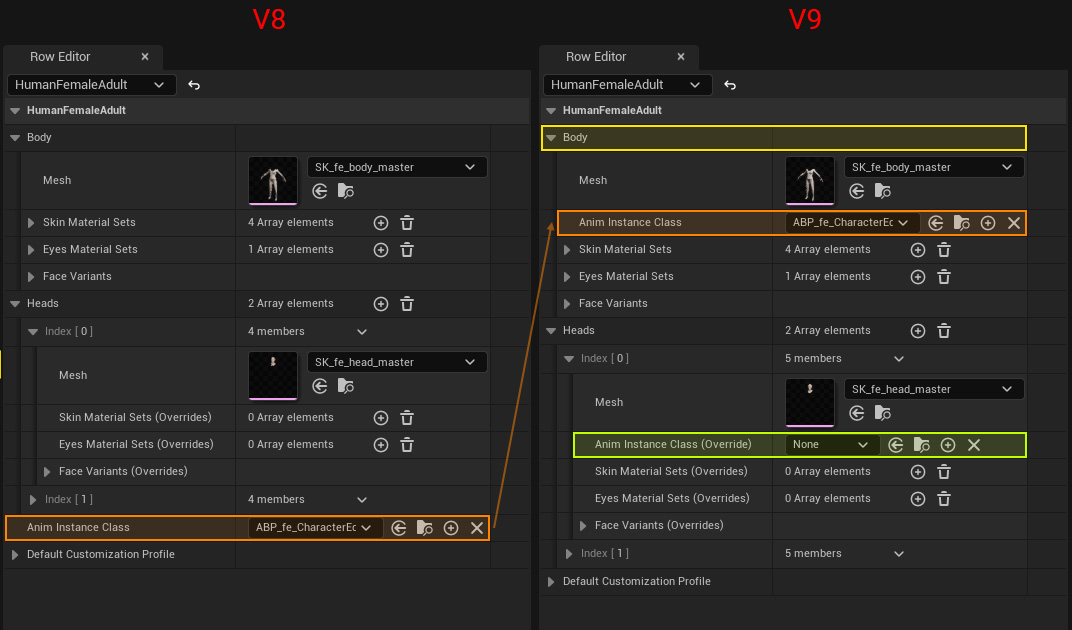
- [Highlight] With this version of the data table and its structures, you can manage Heads > Anim Instance Class (Override) to use individual Anim Blueprints for each head. Modern development approaches may split animation behavior and logic into separate Blueprints, especially when they tend to get more complex. Thus, we wanted to give that support to you.
- [Added] DT_AnatomyProfiles_V9 data table and corresponding structures
- [Added] Table Version Validation for data table
DT_AnatomyProfiles - [Added]
BP_CharacterCustomization>GetCurrentAnatomyBodyAnimInstanceClass - [Added]
BP_CharacterCustomization>GetCurrentAnatomyHeadAnimInstanceClass
¶ Customization Profile V9 (Weight and Muscles for Meta Humans)
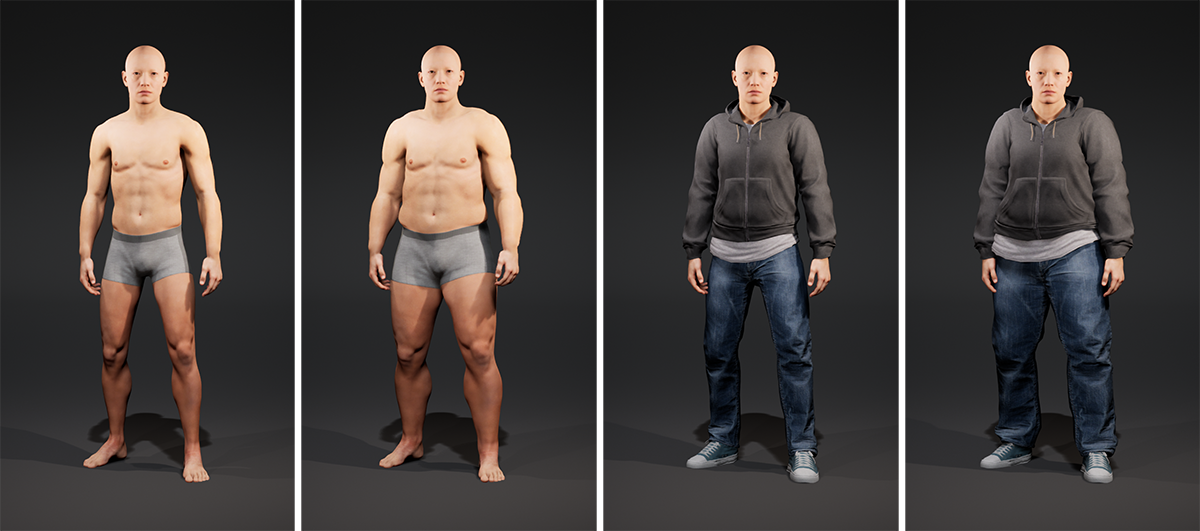

- [Highlight] Meta Human anatomy supports
WeightandMuscles!
Since Morph Targets are not natively available on Meta Human meshes,ABP_Manny/ABP_Quinngot a new Control Rigs approach to transform the skeleton instead of morphing the mesh. To streamline the implementation, we have also convertedAgeandSizetransforms to Control Rigs forABP_Manny/ABP_Quinn(UE5 skeleton) andABP_ma_CharacterEditor/ABP_fe_CharacterEditor(UE4 skeleton).
With the new Customization Profile V9 that data is now stored in the newBasebody> Anim Instance Alphas as named float values rather than fixed values (like the oldAgeandSize). All those "alphas" are passed to the basebody anim instance similar to how HDR color and scalar parameters are passed to materials, thus you can use them for custom functionality as well.
Furthermore, we refactoredABP_fe_CharacterEditor(female) to be a Child Blueprint ofABP_ma_CharacterEditor(male), likeABP_Quinn(female) is one ofABP_Manny(male). This way you only need to modify one Anim Blueprint to develop features on both male and female.
-
[Added] Added Customization Profile V9 > Basebody > Anim Instance Alphas
-
[Added] Added Table Version Validation for data table
DT_PresetCustomizationProfiles -
[Added] Added
Age,Size,WeightandMusclesControl Rigs toABP_Manny -
[Added] Added
AgeandSizeControl Rigs toABP_ma_CharacterEditor
-
[Updated] Replaced
CharacterAnimInstanceInterface>SetAge,SetSize, andSetFootTransformswith new genericSetBasebodyAnimInstanceAlpha, using the same function to pass newWeightandMuscles. -
[Updated] Updated
WBP_CharacterEditorshape sliders to use the new Anim Instance Alphas. Human and Meta Human sliders got distinct names, which describe how they control the shape:

MorphcallsSetBasebodyMorphTarget (Replicable)AnimcallsSetBasebodyAnimInstanceAlpha (Replicable)Multiis a custom example that callsSetBasebodyAnimInstanceAlpha (Replicable),SetBasebodyMorphTarget (Replicable), andSetSkinScalarParameter (Replicable), where the morph target and skin parameter are only available on our Human skin material.
-
[Updated] Replaced
BP_CharacterCustomization>OnSizeChangedwithOnSet_AnimInstanceAlphas(see New Event Dispatchers below for more details).BP_CameraStudiolistens for the new event and updates the camera location if namesAgeorSizegot changed.
¶ Set and Remove CDAs (Improvements)
- [Highlight] We improved the removal feature by introducing events and functions that properly remove profiles instead of setting empty profiles, also allowing to bind to dedicated removal event dispatchers (explained below). The set function can now properly be used to remove as well. Additionally, the functions have clearer names than before.
See Set and Replace CDAs and Remove CDAs for details.
-
[Added]
RemoveCDA...(Replicable)events remove one CDA with inputClassandIndex.Index = -1removes all CDAs of the given class.RemoveCDA_ApparelProfile (Replicable)(replaces [V7 removed]RemoveApparel)RemoveCDA_AttachmentProfile (Replicable)RemoveCDA_EquipmentProfile (Replicable)RemoveCDA_GroomProfile (Replicable)RemoveCDA_HairstyleProfile (Replicable)(replaces [V7 removed]RemoveHairstyle)RemoveCDA_Profile (Replicable)
(can be used for any of the above, includingBP_CustomizationDataAssetitself)
-
[Added]
RemoveAllCDA...(Replicable)functions callRemoveCDA...(Replicable)events with fixed values forClassandIndex = -1.RemoveAllCDA_ApparelProfiles (Replicable)(formerRemoveAllApparels)RemoveAllCDA_AttachmentProfiles (Replicable)RemoveAllCDA_EquipmentProfiles (Replicable)RemoveAllCDA_GroomProfiles (Replicable)RemoveAllCDA_HairstyleProfiles (Replicable)RemoveAllCDA_Profiles (Replicable)
(can be used to clear all CDAs from the character)
-
[Updated]
SetCDA...functions are now callingRemoveCDA...functions to properly clear the CDA instead of setting the CDA toNoneif an empty profile (withData Asset = None) is passed to the function.Still, keep calling
SetCDA...(Replicable)events instead ofSetCDA...functions for replication support.SetCDA_ApparelProfilesSetCDA_AttachmentProfilesSetCDA_EquipmentProfilesSetCDA_GroomProfilesSetCDA_HairstyleProfiles
¶ Randomize CDAs (Improvement)
- [Highlight] Added new randomization functions and renamed old ones. The new helper functions replace the hard-coded implementation of
RandomizeApparelandRandomizeHairstyleby using the Package Registry to get available classes dynamically, allowing you to also randomize any created custom CDA subclasses of Apparel, Attachments, Equipments, Groom, and Hairstyle.
See Randomize CDAs for details.
This feature is Blueprint-only and not implemented in
WBP_CharacterEditorwidgets. Currently, the editor has its own randomization functionality based on the CDA pickers' content.
-
[Added]
SetRandomCDA...(Replicable)randomize one CDA with inputClass,Index,Collection, andAcceptDebugAssets.SetRandomCDA_ApparelProfile (Replicable)(replaces [V7 removed]SetRandomCDA_ApparelProfile)SetRandomCDA_AttachmentProfile (Replicable)SetRandomCDA_EquipmentProfile (Replicable)SetRandomCDA_GroomProfile (Replicable)SetRandomCDA_HairstyleProfile (Replicable)(replaces [V7 removed]SetRandomCDA_HairstyleProfile)SetRandomCDA_Profile (Replicable)
(can be used for any of the above, except forBP_CustomizationDataAssetitself)
-
[Added]
Randomize...(Replicable)helper functions callSetRandomCDA...(Replicable)functions for every available class with inputClass,Index,Collection, andAcceptDebugAssets.RandomizeApparel (Replicable)(replaces [V7 removed]RandomizeApparel)RandomizeAttachments (Replicable)RandomizeEquipment (Replicable)RandomizeGroom (Replicable)RandomizeHairstyle (Replicable)(replaces [V7 removed]RandomizeHairstyle)RandomizeCDAs (Replicable)
(is used by the functions below, but can be used on its own to randomize any class)
¶ Streamlined "Get Current ..."
- [Highlight] To improve the communication between BP_CharacterCustomization and other Blueprints, we replaced all getter macros from
BP_CharacterCustomizationandWBP_CharacterEditorwith getter functions fromBP_CharacterCustomization. Besides that we added new ones to access all properties of the Customization Profile and renamed a few for consistency.
By having this "single source of truth" we remove duplicated code in other Blueprints. This also very useful when working with the new event dispatchers, outlined below. This way you may handle the customization in your custom Blueprints easier.
Except from the functions ones mentioned in the additions below, other new ones are simple quick accesses to the corresponding properties without any special logic.
- [Added] Added
GetCurrentCDA_Profiles_LastIndexandGetCurrentCDA_Profiles_Lengthto get the last index or length of the CDA profiles array associated to the given class. E.g. classBP_CDA_Apparel_Cor any of its child classes would return the last index or length of the currentCDA_ApparelProfilesarray.
-
[Updated] Replaced, renamed and added functions:
- Customization Data Assets
- Apparel
GetCurrentApparelProfileGetCurrentCDA_ApparelProfiles
- Attachments
GetCurrentAttachmentsProfileGetCurrentCDA_AttachmentsProfiles
- Equipment
GetCurrentEquipmentProfileGetCurrentCDA_EquipmentProfiles
- Groom
GetCurrentGroomProfileGetCurrentCDA_GroomProfiles
- Hairstyle
GetCurrentHairstyleProfileGetCurrentCDA_HairstyleProfiles
GetCurrentCDA_Profiles_LastIndex(new)GetCurrentCDA_Profiles_Length(new)
- Apparel
- Basebody
- Body
GetCurrentBodyProfile(new)
- Head
GetCurrentHeadProfile
- Morph Targets
GetCurrentMorphTargetsGetCurrentMorphTargetGroups(formerGet Current Morph Groups)
- Skin
GetCurrentSkinProfileGetCurrentSkinMaterialSets
- Eyes
GetCurrentEyesProfile
- Face
GetCurrentFaceVariants
- Anim Instance Alphas (new)
GetCurrentBasebodyAnimInstanceAlphas(new)
GetCurrentBasebodyProfile
- Body
- Customization Profile
GetCurrentCustomizationProfileGetCurrentCustomizationProfileMetaData(new)
- Anatomy
GetCurrentAnatomyGetCurrentAnatomyBodyAnimInstanceClass(new)GetCurrentAnatomyBodyMesh(formerGetCurrentBodyMesh)GetCurrentAnatomyBodyProfile(new)GetCurrentAnatomyHeadAnimInstanceClass(new)GetCurrentAnatomyHeadMesh(formerGetCurrentHeadMesh)GetCurrentAnatomyHeadProfile (Selected)GetCurrentAnatomyHeadProfiles(new)GetCurrentAnatomyProfile
- Customization Data Assets
¶ New Event Dispatchers
We introduced a lot of event dispatchers to hopefully support you with integrating the Character Editor with other systems.
¶ BP_CharacterCustomization
- [Highlight] All major
Set...andUpdate...functionality got corresponding event dispatchersOnSet_...andOnUpdated_...allow you to hook intoBP_CharacterCustomizationlogic, without needing you to modify the actual component. Functionality, that rebuilds mesh components also gotOnBefore_...event dispatchers. CDA-related functionalty gotOnAdded_...andOnSkipped_...event dispatchers. All dispatchers pass a reference to the callingBP_CharacterCustomization.
- [Added] Added event dispatchers to
BP_CharacterCustomization
- [Updated] Pass self reference on event
OnInitialized - [Updated] To demonstrate a first use-case, we have moved the apparel-specific settings from
UpdateAppareltoBP_Character:- Moved
Cleanup Foot TransformstoBP_Character>ClearApparelSpcificSettings, which is bound toBP_CharacterCustomization > OnBeforeUpdate_Apparel - Moved
Apparel-specific settingstoBP_Character > ApplyApparelSpcificSettings, which is bound toBP_CharacterCustomization > OnUpdated_Apparel
- Moved
- [Updated] Moved
BP_CharacterCustomization > UpdateEquipment > Equipment-specific attachmentstoBP_CharacterCustomization > AddCDA_Skeletal, which now natively supports attachments via pinsSocketNameandRelativeTransform.
¶ BP_CharacterEditor
- [Highlight] New event dispatchers before and after opening, closing, showing and hiding that are called as explained in the schema below. (Events are displayed in red, dispatchers in blue and general logic in grey.) All dispatchers pass a reference to the calling
BP_CharacterEditor.OnOpenedandOnClosedwere previously calledOnOpenandOnClose.
- [Updated] Pass self reference on event
OnInitialized,OnOpenandOnClose - [Updated] Handle multiple local Character Editors: extracted visual events from
OpenEditorandCloseEditor(as shown above)
¶ WBP_CharacterEditor
- [Added] Added
EquipmentGlobalbindings to HDR Color Pickers and Float Sliders, in case you want to add Global HDR Color Pickers or Global Scalar pickers for them
¶ BP_EventDispatcherTester

To test and see when the event dispatchers are called, you can use the scene Blueprint BP_EventDispatcherTester, while using the in-game editor. Place the actor in the level and assign the Character that you are about to control. The Character Customization reference will be set automatically, if it is a suiting character. We recommnd you to set the character's debug mode to Show Errors, Warnings and Verbose Information.
Afterwards, press play and take a look at the Output Log. Alongside the usual debug log, you will see all the called events in the form of warnings to make them visiually different. Besides their name, they print out the most relevant passed properties, you can use. If you can see something like x Morph Targets, x BodyMIDs or x HeadMIDs this refers to an array.

Take a look at BP_EventDispatcherTester on how you could use the different inputs. E.g. function PrintEventDispatcherInfo_AddedCDA_Profile shows you how to incorporate the CharacterCustomization input to call one of the Get Current ... helpers.
¶ Reorganized several functions
- [Highlight] In general, we moved several functions from different categories under one main category, so you can find them better by searching for "Data Assets" or "Customization Data Assets". Some functions got renamed along the way. Some functions are new and got explained in the previous chapters, already.
-
[Updated] BP_CharacterCustomization > Functions
- Customization Data Assets
AddCDA_Groom(formerAddGroomCDA)AddCDA_Skeletal(formerAddSkeletalCDA)AddCDA_Static(formerAddStaticCDA)CleanupCDAsSetRandomCDA_Profile (Replicable)(new)RemoveAllCDA_Profiles (Replicable)(new)RemoveCDA_Profile (Replicable)(new)UpdateAdvancedCDA_Options
- Customization Data Assets > Apparel
GetCurrentApparelProfileGetCurrentCDA_ApparelProfilesRemoveAllCDA_ApparelProfiles (Replicable)(replaces [V7 removed]RemoveAllApparels)RemoveCDA_ApparelProfile(formerRemoveApparel)RemoveDuplicateCDA_ApparelProfilesSetCDA_ApparelProfileSetApparelGlobalHDR_VectorParameterSetApparelGlobalScalarParameterSetRandomCDA_ApparelProfile (Replicable)(replaces [V7 removed]SetRandomCDA_ApparelProfile)UpdateApparelUpdateApparelBasebodyMasks
- Customization Data Assets > Attachments
GetCurrentAttachmentProfileGetCurrentCDA_AttachmentProfilesRemoveAllCDA_AttachmentProfiles (Replicable)(new)RemoveCDA_AttachmentProfile(new)RemoveDuplicateCDA_AttachmentProfilesSetCDA_AttachmentProfileSetAttachmentGlobalHDR_VectorParameterSetAttachmentGlobalScalarParameterSetRandomCDA_AttachmentProfile (Replicable)(new)UpdateAttachments
- Customization Data Assets > Equipment
GetCurrentEquipmentProfileGetCurrentCDA_EquipmentProfilesRemoveAllCDA_EquipmentProfiles (Replicable)(new)RemoveCDA_EquipmentProfile(new)RemoveDuplicateCDA_EquipmentProfilesSetCDA_EquipmentProfileSetEquipmentGlobalHDR_VectorParameterSetEquipmentGlobalScalarParameterSetRandomCDA_EquipmentProfile (Replicable)(new)UpdateEquipment
- Customization Data Assets > Groom
GetCurrentGroomProfileGetCurrentCDA_GroomProfilesRemoveAllCDA_GroomProfiles (Replicable)(new)RemoveCDA_GroomProfile(new)RemoveDuplicateCDA_GroomProfilesSetCDA_GroomProfileSetGroomGlobalHDR_VectorParameterSetGroomGlobalScalarParameterSetRandomCDA_GroomProfile (Replicable)(new)UpdateGroom
- Customization Data Assets > Hairstyle
GetCurrentHairstyleProfileGetCurrentCDA_HairstyleProfilesRemoveAllCDA_HairstyleProfiles (Replicable)(new)RemoveCDA_HairstyleProfile(replaces [V7 removed]RemoveHairstyle)RemoveDuplicateCDA_HairstyleProfilesSetCDA_HairstyleProfileSetHairstyleGlobalHDR_VectorParameterSetHairstyleGlobalScalarParameterSetRandomCDA_HairstyleProfile (Replicable)(replaces [V7 removed]SetRandomCDA_HairstyleProfile)UpdateHairstyle
- Customization Data Assets
-
[Updated] BP_CharacterCustomization > Macros
- Customization Data Assets
Is CDA Visible
- Customization Data Assets
-
[Updated] BP_CharacterCustomization > Variables
- Customization Data Assets
HiddenCDA_ClassesPackageRegistry
- Customization Data Assets > Apparel
ActiveAdditionalMorphTargets_ApparelApparelMeshComponentsMID_ApparelGlobalsUseAlternativeSkinTextures
- Customization Data Assets > Attachments
AttachmentMeshComponentsMID_AttachmentsGlobals
- Customization Data Assets > Equipment
ActiveAdditionalMorphTargets_EquipmentEquipmentMeshComponentsMID_EquipmentGlobals
- Customization Data Assets > Groom
GroomComponentsMID_GroomGlobals
- Customization Data Assets > Hairstyle
ActiveAdditionalMorphTargets_HairstyleHairstyleMeshComponentsMID_HairstyleGlobals
- Customization Data Assets
-
[Updated] CharacterEditorFunctionLibrary > Utilties > Customization
- Customization Data Assets
DoesCDA_PassesFilterSettingsGetCDA_AssetDataGetCDA_FromAssetRegistryGetAdvancedCDA_OptionsGetFriendlyCDA_NameFilterLoadCDA_FromAssetData
- Customization Data Assets > Apparel
ApparelClassToMaterialParameterNameFilterCDA_ApparelProfilesByClassFindCDA_ApparelProfileGetAdvancedApparelOptions
- Customization Data Assets > Attachments
FilterCDA_AttachmentProfilesByClassFindCDA_AttachmentProfile
- Customization Data Assets > Equipment
FilterCDA_EquipmentProfilesByClassFindCDA_EquipmentlProfile
- Customization Data Assets > Groom
FilterCDA_GroomProfilesByClassFind CDA Groom Profile
- Customization Data Assets > Hairstyle
FilterCDA_HairstyleProfilesByClassFindCDA_HairstyleProfile
- Customization Data Assets
¶ Documentation Changes
- [Added] BP_CharacterCustomization > Set and Replace CDAs
- [Added] BP_CharacterCustomization > Remove CDAs
- [Added] Tutorials > Third Party Integration: Meta Humans > FAQ / Common Issues
- [Updated] BP_CharacterCustomization > Randomize CDAs
- [Updated] Moved Known Issue chapters to their corresponding tutorials:
- Groom to Tutorials > Third Party Integration: Groom for Meta Humans > FAQ / Common Issues
- Multiplayer to Tutorials > Package Project for Multiplayer > FAQ / Common Issues
¶ V8 Groom Update
¶ Groom
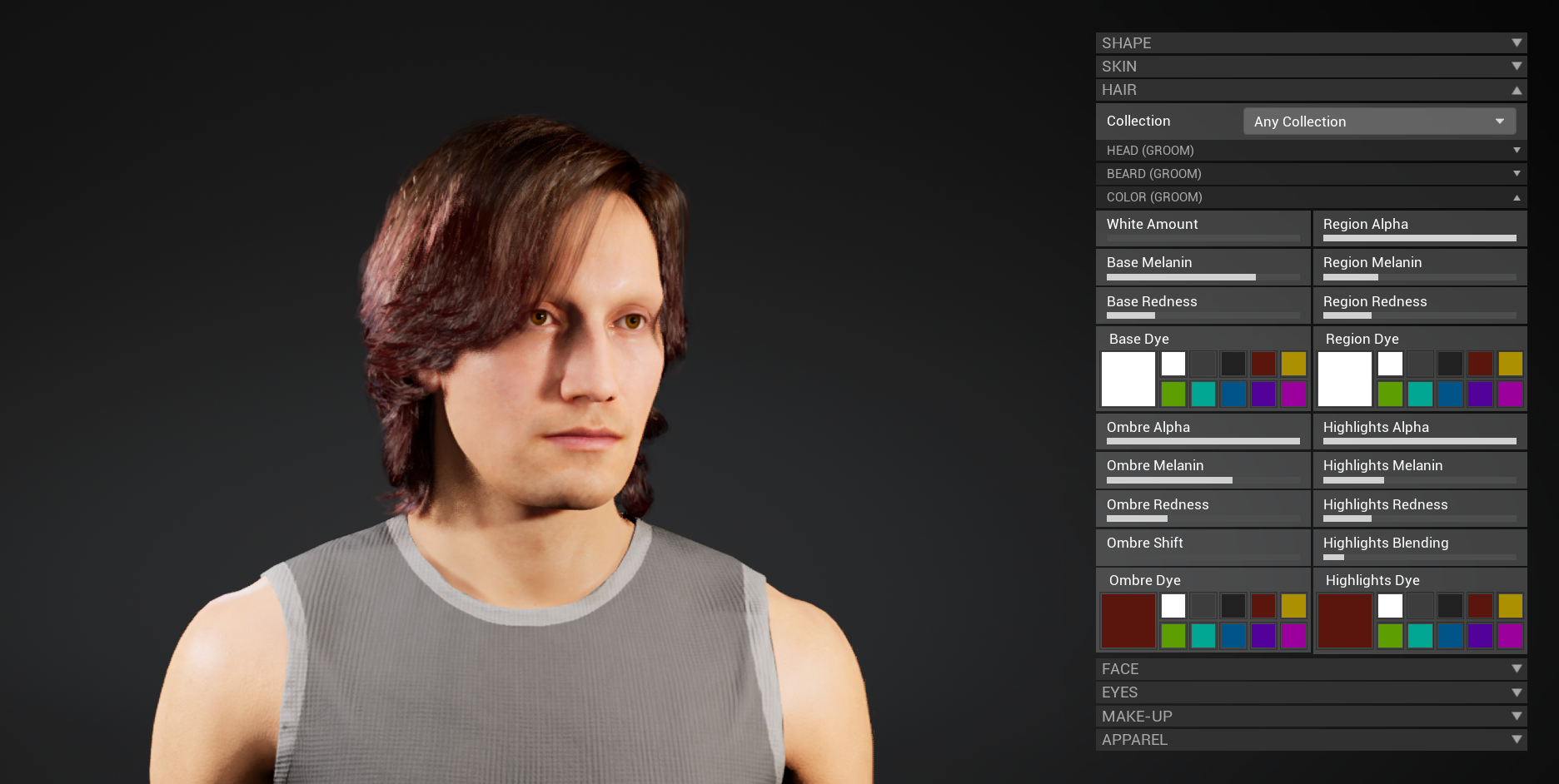
- [Highlight] Groom support has been extended after further evaluation! It is currently only supported for the MetaHuman anatomy and Groom assets are not delivered with this update. See further release notes and tutorial Third Party Integration: Groom for MetaHumans for details to learn how to implement your own Groom assets.
- [Added] BP_CDA_Groom got new child classes
BP_CDA_Groom_HeadandBP_CDA_Groom_Beard. - [Added] BP_CDA_Groom >
BindingAssetsreplacesBindingAssetto support multiple head meshes. - [Added] BP_CDA_Groom >
HiddenClassessupport has been added. - [Added] CDA Groom Pickers have been added for both head and beard classes.
- [Added] Float Sliders and HDR Color Pickers below the CDA pickers control the Groom material.
- [Added] Known Issues section for Groom.
- [Updated] BP_CharacterCustomization >
CreateMID_ByMaterialVariantnow creates Dynamic Material Instances on all material slots instead of only the first slot, ifMaterialVariantIndexof-1is given. This is necessary to support Groom coloring across different quality materials (Hair, Cards, Helmet).
¶ Performance


- [Highlight] LODSync component support has been introduced for all default Character Editor skeletal meshes from the
CharacterPartsfolder. This can reduce Prims (primitives count) up to less than 10% of the original asset quality, resulting in better FPS.
- [Added] LODSync explanation.
- [Added] BP_Character > LODSync component.
- [Added] BP_Character > Get LODSync Component interface function.
- [Added] BP_CharacterCustomization > Update LODSync Component function.
- [Added]
CharacterEditor_Showcase_Performancemap with 128 characters in the scene. - [Added] BP_Character > Use Skeletal Merging checkbox. (BETA feature)
- [Added] BP_CharacterCustomization > Update Skeletal Merging function. (BETA feature)
¶ Anatomy Profiles V8

- [Highlight] With this version of the data table and its structures, you can manage the Skin Material Sets, Eyes Material Sets, and Face Variants more straightforward on custom skeletal meshes like MetaHumans that can be adjusted with Character Editor controls. With these changes you are no longer tied to hardcoded material slot and face variant names as well as pre-defined materials on your different Anatomy skeletal meshes. Combined meshes (like our children) also benefit from the optional overrides approach on individual head entries which had been introdocued in V7 Customer Update.
- [Added] DT_AnatomyProfiles_V8 data table and corresponding structures.
- [Added]
BP_CharacterCustomization>GetCurrentFaceVariantsto pass face variants to Character Editor. - [Added] Float Sliders to control the MetaHuman eyes material.
- [Updated]
BP_Character>AnatomyDataTabledefault set toDT_AnatomyProfiles_V8. - [Updated]
BP_CharacterCustomization>AnatomyDataTabledefault set toDT_AnatomyProfiles_V8. - [Updated]
BP_CharacterCustomization> UpdateSkinMaterials - [Updated]
BP_CharacterCustomization> UpdateEyesMaterials - [Updated]
BP_CharacterCustomization>SetHeadIndexto update skin and eyes according to the new logic. - [Updated]
WBP_CharacterEditor>Event Graph>Initialize - Face Heads And Variants.
¶ Miscellaneous
- [Added] A verbose information log shows if a CDA was skipped due to hidden classs of other CDAs.
- [Added] Hidden Collections allow filtering collections out from
WBP_CDA_CollectionPicker. - [Added]
Base/Tutorial/folder with dedicated assets for a first tutorial with example content.
- [Updated] Hide unused
WeightandMusclesfloat sliders in MetaHuman anatomy. - [Updated] Disable unused
Skincolor picker in MetaHuman anatomy. - [Updated] Disable unused
Beta Featuresin MetaHuman anatomy and toggle them if they were open.
- [Fixed]
BP_Character_simple_no_editor_usagemorph target application. - [Fixed]
DT_CustomizationProfiles_V7was missing Basebody settings (morphs, skin, etc.). - [Fixed] CDA Collection Picker was not properly remembering its collection after switching anatomies.
- [Fixed] Character Editor Tools was removing Apparels instead of Hairstyle.
- [Fixed] Deleting Customization Profiles in the Profile Manager was not properly saved to the save game file.
- [Fixed] Restored square button styles in Character Editor widgets that got removed when Unreal Engine 5.0 introduced button
Outline Settingswith a defaultCorner Radiusof4.0, which did not match our style guide.
¶ Documentation Changes
- [Added] Tutorial: Third Party Integration: MetaHumans
- [Added] Tutorial: Third Party Integration: Groom for MetaHumans
- [Added] Tutorial: Third Party Integration: Easy Survival RPG v4 (ESRPG v4)
- [Added] Tutorial: Third Party Integration: Advanced Locomotion System V4 (ALS V4)
(Updated version from PDF documentation) - [Added] Tutorial: Persist Current Customization Profile between different levels
(Updated version from PDF documentation with example content)
- [Updated] BP_Character structure and content.
- [Updated]
BP_CharacterCustomization> Function: Apply Customization Profile structure and content. - [Updated] WBP_CharacterEditor structure and content.
- [Updated] Character Editor Tools got an embedded YouTube video.
- [Updated] In-game Controls reorganized and added implementation details.
- [Updated] BP_Character > Character Controls references to the new implementation details.
- [Updated] Collections introduces explanations from previous updates.
- [Updated] CDA Loader was missing its image.
- [Improved] New change log structure, icons and hover tooltips on entries.
- [Improved] Links pointing to headings on the same page show a paragraph icon like: Example Link
- [Improved] Links in general are bolder now to emphasize connections to other topics.
- [Improved] Page navigation highlights the currently selected page.
- [Improved] YouTube videos can be embedded into the documentation.
- [Improved] Version badges are now less distracting: [V1] [V2] ... [V7] [V8]
¶ V7 Customer Update
This time we mainly focused on the direct needs and wishes of you, the customers.
Additionally, we launched this Wiki to support you in a more contemporary way.
Watch on YouTube: Character Editor Update
¶ Pack Content Changes
- [Added] Multiple Head meshes support in Anatomy Profiles data table, while keeping individual face variant morph targets.
- [Added] Randomization functions in BP_CharacterCustomization for RandomizeApparel and RandomizeHairstyle.
- [Added] Character Editor Tools utility widget to randomize your character from the Unreal Editor.
- [Added] Basic Groom Work-In-Progress support without any Customization Data Assets, yet, for evaluation.
¶ Documentation Changes
- [Highlight] Wiki Documentation launched! PDF documentation will be deprecated.
- [Updated] Function: Initialize from Character Begin Play and Randomize CDAs to explain the randomization functions.
- [Updated] Basebody Profile, DT_AnatomyProfiles, and Index Picker to explain the multiple head meshes support.
- [Added] Package Registry and Character Editor Tools to explain the new editor utility widget.
- [Added] BP_CDA_Groom and CDA Groom Picker to explain the current status of that feature.
¶ V6 Replication Update
Note for returning customers:
You should read the updated BP_Character, BP_CharacterCustomization component and BP_CharacterEditor component sections from start to end, even if you already know the old ones by heart. They changed quite a lot.
¶ Pack Content Changes
- [Highlight] Replication support for the Character Customization and Editor.
- [Added] New map CharacterEditor_Showcase_Replication.
- [Added] BP_Character > “Preset Profile Names” variable, which lists all customization profiles of the currently assigned “Preset Data Table”.
- [Added] BP_Character > “Load Random Profile on Begin Play” variable, which is useful for testing replication and chooses a random profile from saved and preset profiles. Saved profiles overrule presets if they have the same name.
- [Added] BP_Character > “Anatomy Data Table”, which let you select a different set of anatomy profiles (e.g., for easily testing different body meshes on same anatomy profiles – had to be used by us because we were not allowed to submit MetaHuman meshes.)
- [Added] BP_CharacterEditorGameMode and assigned it as default in our showcase maps to test replication with BP_Character as default pawn.
- [Updated] Adult male and female mesh to both use the UE4 Mannequin.
- [Updated] BP_CharacterCustomization debug output, added a new debug level “detailed information” and updated BP_Character to show errors, warnings, and information by default.
- [Updated] Texture settings on all ID masks to use Default compression, because some of them were configured differently.
- [Updated] SetBasebodyMorphTarget functions to set morph targets on all meshes instead of just on the master pose mesh, as upgrading to UE4.27 made it necessary to do so.
- [Updated] Profile Manager to always load the current Anatomy Profile of the character even if the Manager was initialized with a closed Character Editor.
- [Removed] The necessity to load customization profiles from within the WBP_ProfileManager initialization if Character Editor shall open on initialization. Now, BP_CharacterCustomization handles all loading on its own.
- [Removed] Unused variant pickers from “Face > Nose”, “Face > Mouth” and “Face > Eyes” sections.
- [Removed] Deprecated map CharacterEditor_Showcase__LightStudio (with two underscores in the name).
¶ Documentation Changes
- [Added] Tutorial: Package the Project for Multiplayer (Dedicated Server)
- [Added] Known Issues section
- [Updated] “Using the Blueprints” section a lot to match the new features.
¶ V5 MetaHuman Update
¶ Content Changes
- [Highlight] Anatomy support for MetaHumans.
- [Added] Skeletal meshes ported to the MetaHuman TAL NRW body type. Some editor logic is not yet supported on MetaHumans like weight and eye variations.
- [Added] Pattern Blend known from apparel patterns to default skin material to support tattoos, paintings etc. originally used in the Barbarian asset pack.
- [Added] Dispatchers OnOpen and OnClose to BP_CharacterEditor.
- [Added] Support for inverted ranges in Float Sliders (Min greater than Max) as Lips Roughness had to be inverted, because of the “Lips Gloss” naming.
- [Updated] BP_Character to only initialize Character Editor component if controlled by a player to avoid spawning widgets for NPCs in your view.
- [Fixed] Hair color got reset on updating other CDAs.
- [Fixed] Children eye material could not be modified (color, iris & pupil scale).
- [Fixed] Material channel names on a few body and head meshes.
¶ Documentation Changes
- [Updated] In-game Controls with a new control visualization.
- [Updated] Assigning CDAs to Anatomy Profiles to its own chapter.
- [Added] Using Default Anatomy [V5] to explain UE4 Mannequin setup.
- [Added] Using MetaHuman Anatomy [V5] including a YouTube tutorial.
¶ V4 Animation Update
Note for returning customers:
See Tutorial: Upgrade Character Editor from Version 2 to Version 4.
¶ Content Changes
- [Highlight] New CDA animation workflow and added it to all skeletal CDAs.
- [Added] Animated example CDA assets (see preset profile “Tyler”).
- [Updated] CDA logic including refactoring CDA classes to skeletal and static bases as well as including a new “Equipment” type.
- [Updated] All skeletons to be ready for Advanced Locomotion System V4.
¶ Documentation Changes
- [Added] Tutorial: Add your own CDA animations to explain CDA animation workflow.
- [Added] Tutorial: Integrate Third Party Content: Advanced Locomotion System V4.
- [Added] Tutorial: Persist Current Customization Profile between different levels.
- [Updated] BP_CharacterCustomization, Customization Data Assets and Customization Profile to explain the new CDA logic.
¶ V3 Lighting Update
¶ Content Changes
- [Highlight] Light Studio.
- [Added] CDA initialization progress bar.
- [Added] Hand apparel to the Character Editor widget.
- [Added] Alternative skin texture support to CDA.
- [Added] Additional shortcuts.
- [Updated] System to hide other CDAs. (Hidden CDA Classes)
- [Updated] Collection Picker to switch to “Any Collection” when loading profile.
- [Updated] Randomization to consider material variants as well.
- [Updated] Various mesh skinning.
- [Updated] Various textures.
- [Updated] Apparel picker to carefully select applied apparel in all situations.
- [Improved] Compatibility to our other packs.
- [Improved] Performance when opening the Character Editor widget in editor.
¶ Documentation Changes
- [Added] Introduced Version Tags.
¶ V2 Anatomy Update
¶ Content Changes
- [Highlight] New anatomy and collection system for Customization Data Assets.
- [Added] Boys and girl basebody.
- [Added] Beards to the male adults.
- [Added] Attachment CDA type (example: hammer).
- [Added] Wrinkle maps to a separate M_SkinAdvanced material.
- [Updated] Customization Profile structure.
- [Updated] How to save Preset Customization Profiles.
- [Updated] In-game Character Editor.
¶ Documentation Changes
- [Updated] Home section by adding a Core Component Overview.
- [Updated] “Using the Blueprints” a lot to match the new features.
- [Updated] “Using the Character Editor” as well.
- [Updated] “Tutorials” to give you more info for special cases.
- [Added] FAQ – Frequently Asked Questions section.
- [Added] Various more detailed information throughout the documentation.
- [Added] Many blue cross references to quickly navigate the documentation.
- [Added] Colored badges for you, who already know the pack from the initial release, to quickly find out where additions and updates happened throughout the documentation.